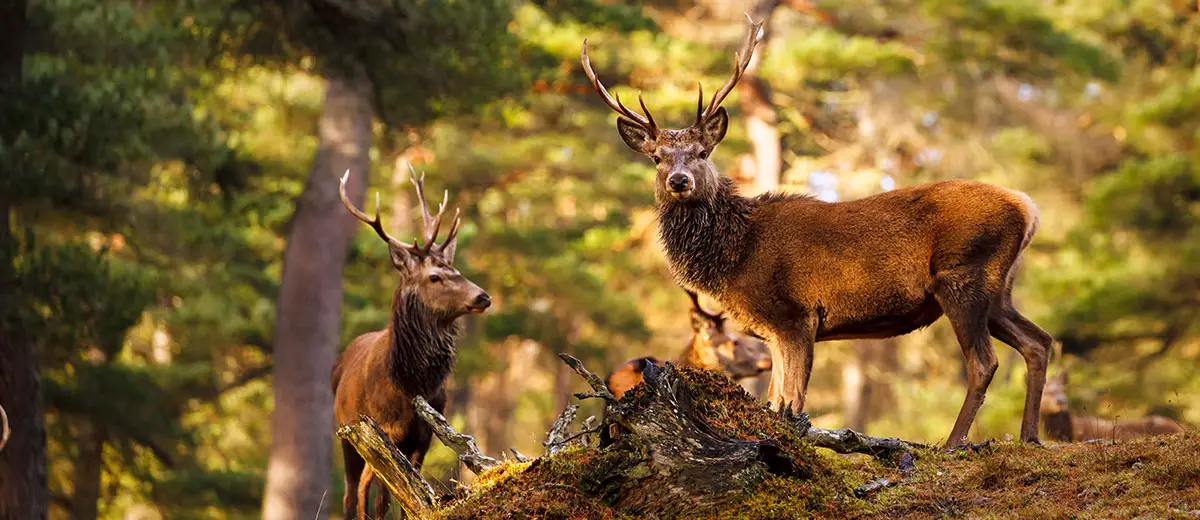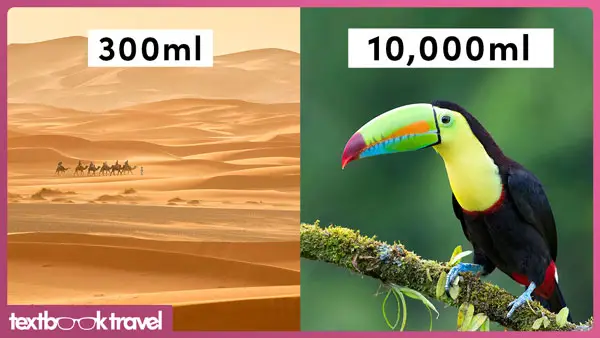11 Types of Biome and Their Animals (With 100+ Photos & Maps)
Biomes are collections of living organisms all of which have evolved to exist in a specific climate. The classification of biomes is a hotly debated topic and itself has evolved over the years as we’ve come to better understand the world around us. In the broadest sense, there are five main types of biome; tundra, forest, grassland, desert and aquatic. What is now debated is how further to categorise each of these biomes as, for example, the flora and fauna found in the wet humid rainforests of Costa Rica are vastly different from those found in the cool pine-ladened forests of Estonia. In the late 1940s, the botanist, Leslie Holdridge developed a matrix that included temperature and precipitation and lead to the further specification of each of these parent categories. In this guide, we’ll discuss the five main biome types and explore further classification where there is some interesting diversity in wildlife. Let’s dive in!
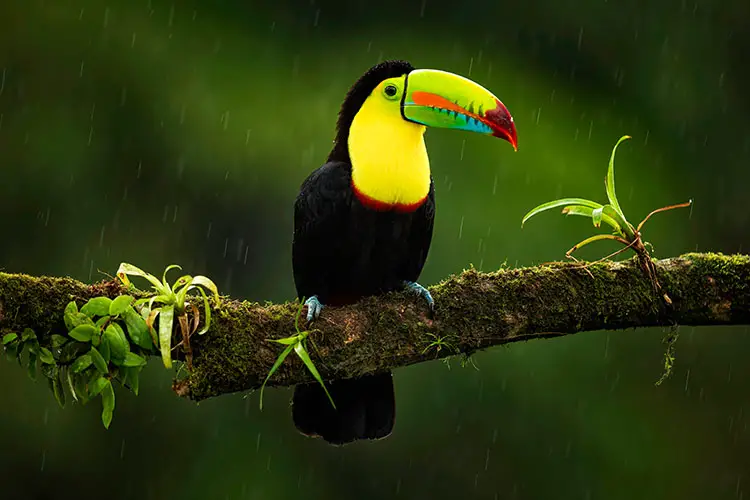
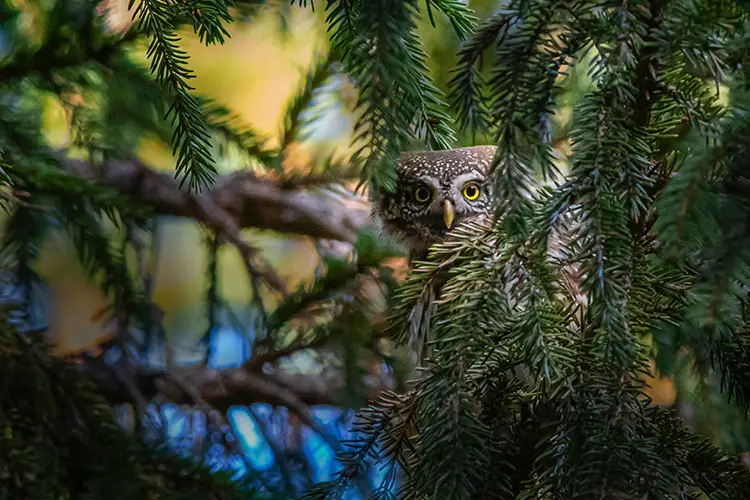
Left – Toucan in the rainforests of Costa Rica | Unsplash: Zdeněk Macháček & Right – Eurasian pygmy owl in the temperate forests of Estonia | Unsplash: Erik Karits
Contents
- Arctic Tundra (reindeer, muskox, polar bear, wolf & snowy owl)
- Alpine Tundra (mountain goat, ibex, snow leopard & golden eagle)
- Antarctic Tundra (king penguin & seal)
- Boreal Forest (wood bison, bull moose, eurasian lynx, brown bear, beaver, stoat, woodpecker & Canada jay)
- Temperate Forest (deer, black bear, chipmunk, badger, red panda, koala and joey, pigeon, robin, cicada & garter snake)
- Tropical Forest (jaguar, anaconda, gorilla, capuchin, sloth, tapir, lovebirds, macaw, green mamba, poison dart frog, swallowtail butterfly & preying mantis)
- Tropical Grassland (african wild dog, hyena, lion, cheetah, rhino, elephant, zebra, wildebeest, Nile crocodile, black mamba, lilac-breasted roller, termites, kangaroo & emu)
- Temperate Grassland (coyote, corsac fox, przewalski’s horse, plains bison, polecat, prairie dogs, sparrows & eastern imperial eagle)
- Desert (camel, bobcat, fennec fox, kangaroo rat, meerkats, rattlesnake, scorpion, roadrunner, burrowing owl, monarch & viceroy butterflies)
- Marine (killer whale, manatee, elephant seal, walrus, saltwater crocodile, hawksbill sea turtle, great white shark, manta ray, clownfish, moray eel, squid, great barrier reef, puffins & blue-footed booby)
- Freshwater (salmon, piranha, mute swans, kingfisher, giant river otter, platypus, axolotl, bullfrog, caiman, red-eared slider turtle, dragonfly & water strider)
Fun (and useful!) Fact
What is the difference between a biome and an ecosystem?
A biome is a collection of flora and fauna that exists in a specific climate. An ecosystem is an ecological unit made up of both living and nonliving elements that interact to form the cycle of life. Any given biome can exist in multiple locations, for example, tropical rainforests are found throughout the equatorial regions of Africa, Asia and the Americas. An ecosystem is a single unit and can only be found in one contiguous location; a tropical rainforest ecosystem that exists in Brazil is completely separate from that of a tropical rainforest ecosystem in the Congo even though they are both found in the same biome.
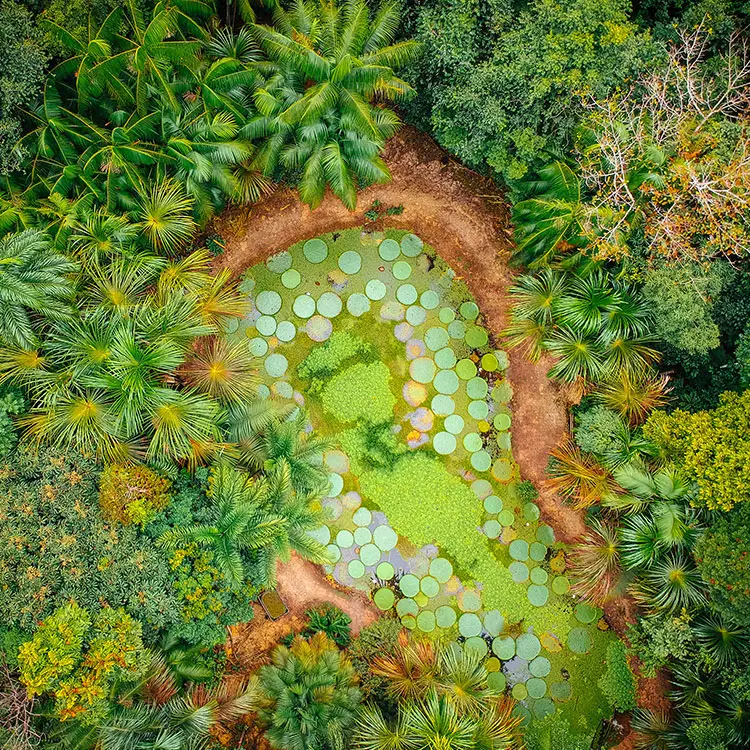
Tundra
Tundra accounts for around 10% of the earth’s landmass and is found in areas where the conditions do not facilitate the growth of trees. Tundra is characterized by extremely low temperatures and low amounts of precipitation. These desolate areas are also tormented by strong winds, making the conditions even less hospitable. Plantlife is limited to the quality of the soil (which is not great!) and in the months where the tundra is not covered in snow, these barren areas are blanketed with colourful mosses, lichens and grasses. Due to the limited vegetation, wildlife is not as abundant as in many of the other biomes but the species that do abide are quite unique. There are three main types of tundra: Arctic, Alpine & Antarctic. The conditions of the Arctic and Antarctic tundra are created due to their latitude—and therefore their proximity to the poles—whereas the conditions that create alpine tundra are due to its altitude.
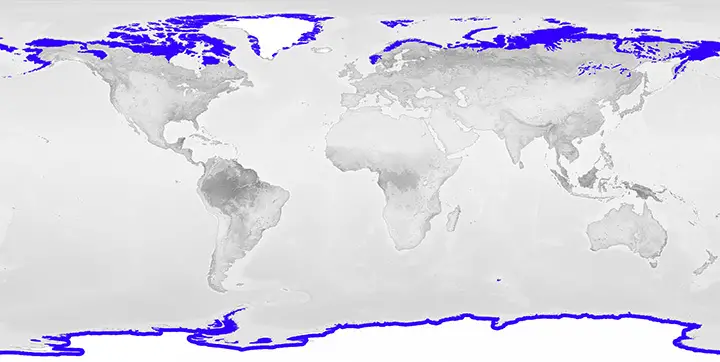
Tundra Facts
- Characteristics: Very cold, very low precipitation and little vegetation
- Temperature Range: -40°C / -40 °F to 18°C / 64°F
- Precipitation: 150 to 250 millimeters / 6 to 10 inches of rain per year
- Vegetation: Mosses, lichens, grasses, sedges & shrubs
Arctic Tundra
In terms of tundra, the Arctic variety is the most well known. This strip of land sits between the Arctic polar ice cap and the taiga belt—a band of boreal forest that runs through Alaska, Canada, northern Europe and Russia. Temperatures in the Arctic tundra range from 4°C / 40°F in the summer to -32°C / -25°F in the winter producing perennially frozen ground known as permafrost. Only 48 species of land mammal inhabit this barren region, all of which have thick fur and are often white or light grey in colour to aid with camouflage. Many animals either migrate in the long winters—such as the birds—or hibernate.
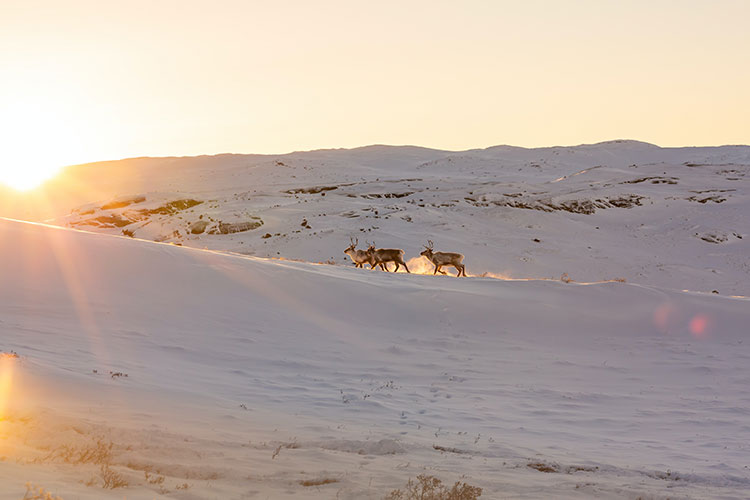
Some of the largest primary consumers on the Arctic tundra include the giant muskox and reindeer—known as caribou in North America—who gorge on the layers of moss and lichen. Reindeer are not exclusive to the tundra; there are many subspecies who live further south in boreal forest and woodland although they are rarely seen south of the Canadian or Russian borders. They are one of the few species on earth to be domesticated and are used by Santa Claus to deliver presents on Christmas! The muskox is one of the few species of megafauna to survive prehistoric hunting by adapting to the arctic region where humans did not typically abide. Other primary consumers include Arctic hares and lemmings.
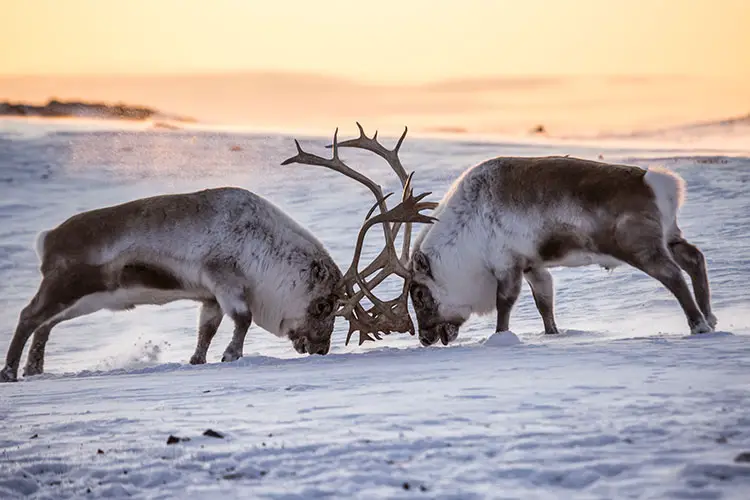
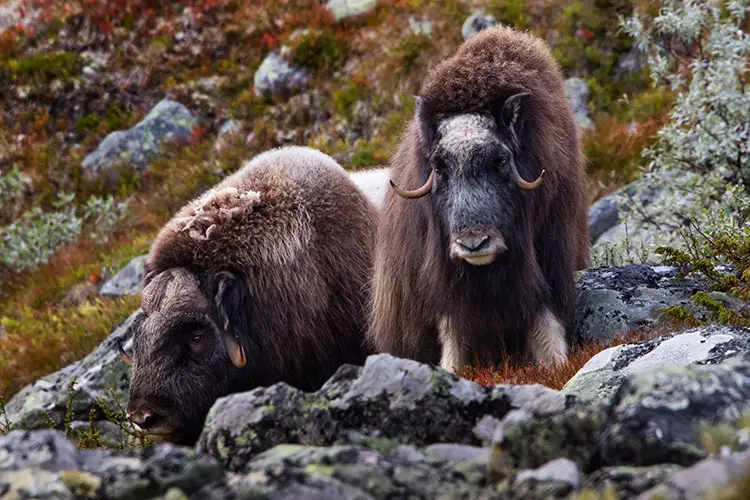
Left – Reindeer fight on southern Spitsbergen & Right – the Muskox (Ovibos moschatus) | Flickr: NTNU
This biome’s most infamous predators include wolves, polar bears and the Arctic fox. Perhaps the most well-known subspecies of wolf to occupy the tundra is the Arctic wolf—a smaller subspecies which exhibits a white fur. On the tundra, wolves prey predominantly on muskox and Arctic hares although they have been known to prey on other primary consumers including reindeer and lemmings. Spending most of their time chilling in the Arctic circle, the majority of a polar bear’s diet is made up of seals. However, should the largest member of the bear family stumble onto the tundra, they have also been known to prey upon muskox and reindeer as well.
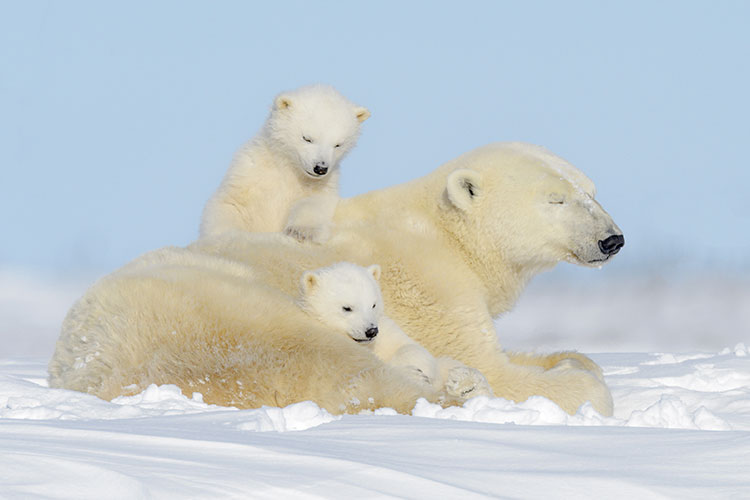
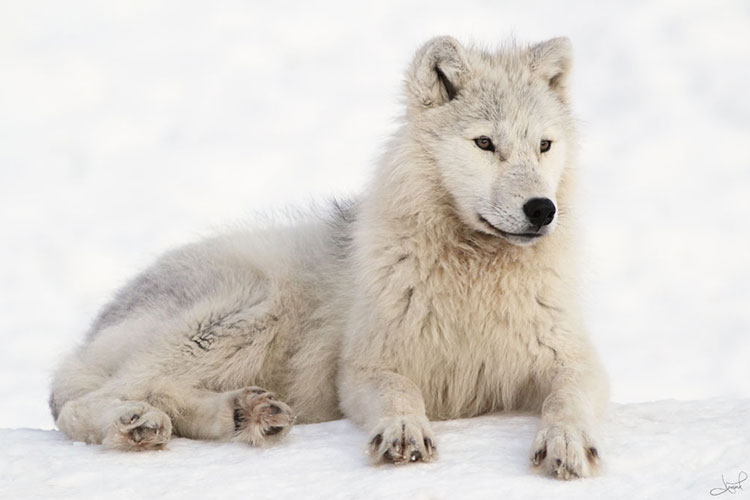
Left – Polar Bear Sow with Cubs in Manitoba & Right – Arctic Wolf in Montebello, Québec | Flickr: tsaiproject
Many species of bird make the long migratory trek north to take advantage of the tundra’s short growing season. Flocks of snow geese, bar-tailed godwits—who migrate over 6,000 miles from New Zealand and Australia—loons, ducks and many more feast in the marshes, bogs and lakes that appear during the summer before migrating south for the long winter months. Not all species of bird here are migratory; the tundra’s most well-known predatory bird, the snowy owl, will stay year-round to feast on lemmings, voles, hares and other species of bird. The snowy owl is one of the largest species of owl with a wingspan of up to 1.65m / 5.5ft.
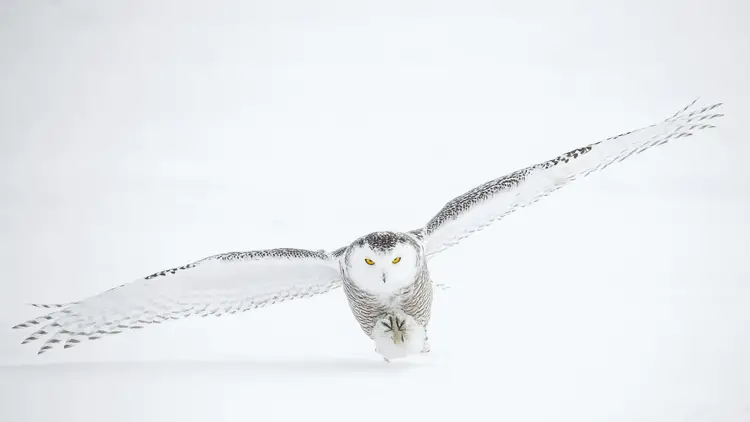
Alpine Tundra
Alpine tundra is found in the extreme mountainous regions of every continent with the exception of Antarctica. Although conditions here are fairly similar to that of the Arctic with low precipitation, low temperatures and high amounts of wind, the alpine tundra is treated to a milder summer and a longer growing season—around 6 months in comparison to the Arctic’s 2. The summer months here can reach a balmy 12°C / 54°F with winters usually staying above -18°C / 0°F. Plantlife in this biome tends to be more extensive than in the Arctic; improved drainage leads to higher soil quality and spectacular flowery meadows in the summer.
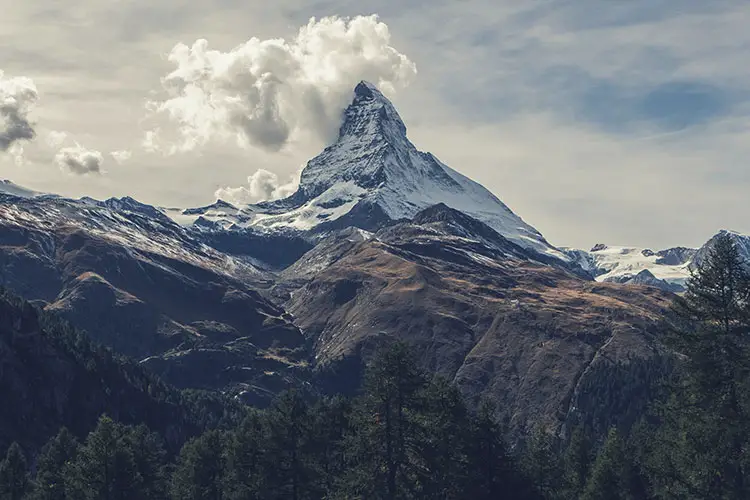
At these altitudes, the grazing muskoxen and reindeer are replaced with mountain goats, argali and ibex to name but a few. Many of these species boast impressive climbing skills, used to traverse the many cliffs and icefields of the alpine. Mountain Goats are found exclusively in the mountain ranges of the western US, Canada and Alaska and spend most of their day grazing in high-altitude alpine meadows. Argali—also known as mountain sheep—are found on the other side of the world in the Altai Mountains, the Himalayas and many other mountain ranges in East Asia.
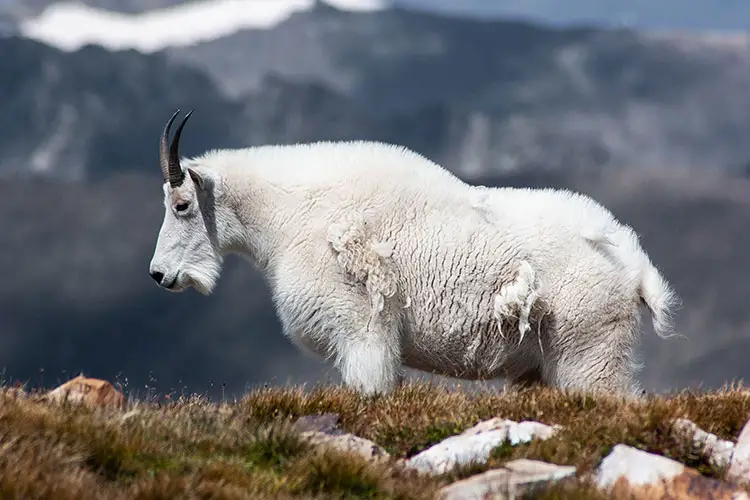
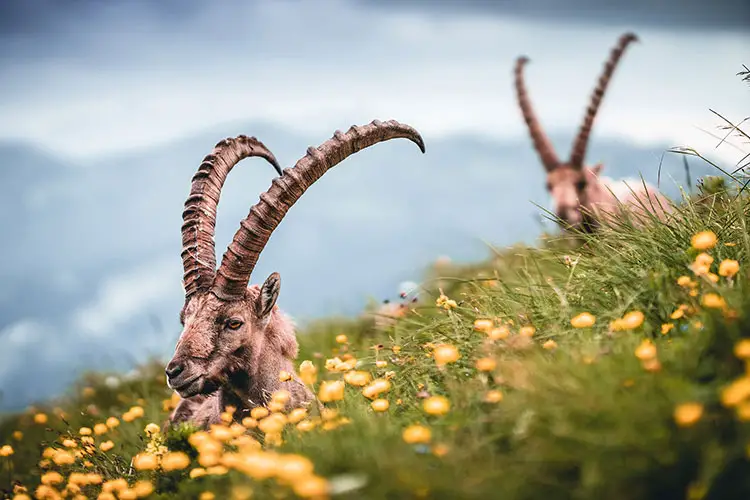
Left – Mountain goat in the alpine | Unsplash: JJ Shev & Right – Ibex in an Alpine Meadow | Pixabay: Felix Mittermeier
Although they are most well-known in the subalpine, wolves and bears can also be found on the mountainous tundra (not polar bears, though!) along with various species of wild cat. The alpine’s most elusive predator, the snow leopard, roams the tundra in search of goats, sheep and smaller mammals such as pika and vole. These beautiful felines are found only in the mountain ranges of East Asia including the Himalayas and the Tibetan Plateau. Their conservation status is currently listed as vulnerable due to poaching and habitat loss.
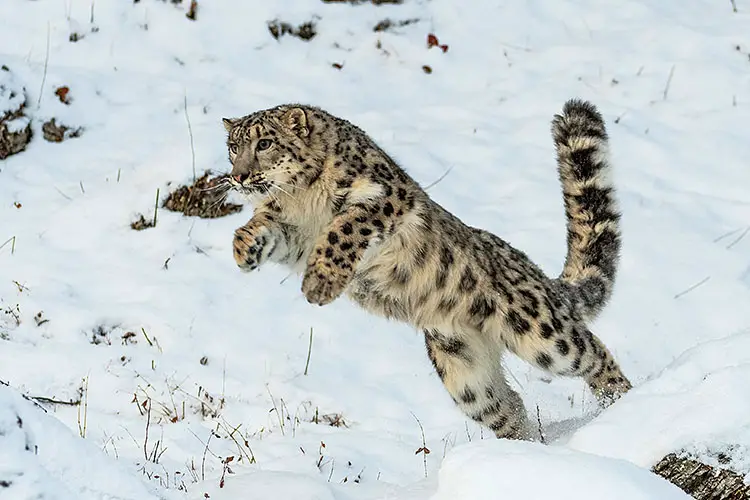
Like the arctic, migratory birds also visit alpine tundra during the summer months, feasting on a buffet of insects and plant life. Several species of birds remain year-round, including the golden eagle whose wingspan can reach close to 8ft. These majestic creatures use the alpine’s strong winds to soar above the open plains in search of small mammals such as marmots. Thanks to the slightly more hospitable conditions in the alpine, there are also many species of insects who enjoy the tundra including butterflies, beetles and grasshoppers.
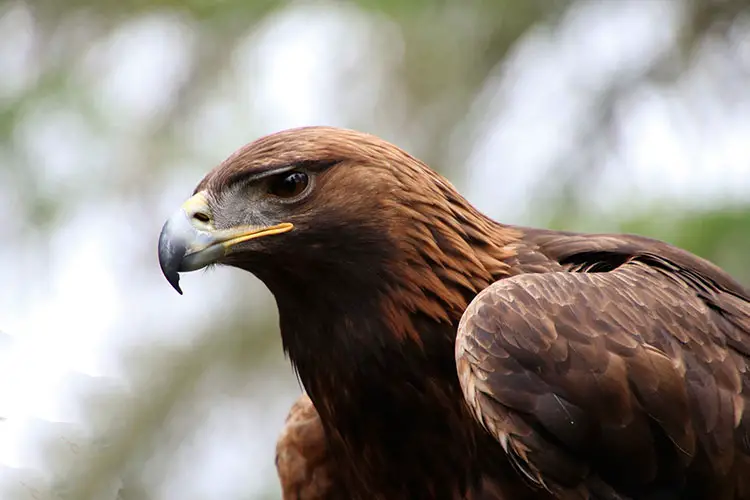
Antarctic Tundra
We’ve covered the two main categories of tundra, but we’ll address one further categorisation briefly thanks to one animal whom it would be a travesty to omit! Although not always included in maps of the tundra biome, the conditions in the Antarctic tundra are very similar to that of the Arctic, with many species of lichens and mosses gifting colour to the often bleak landscape. The Antarctic’s most famous inhabitants are seals and penguins, the latter of which use the pack ice and tundra to breed, often withstanding temperatures as low as −40 °C / −40 °F. The emperor penguin is the largest of all penguin species and lives and breeds exclusively in Antarctica. They can be seen both on land and fishing in the frigid waters while dodging leopard seals!
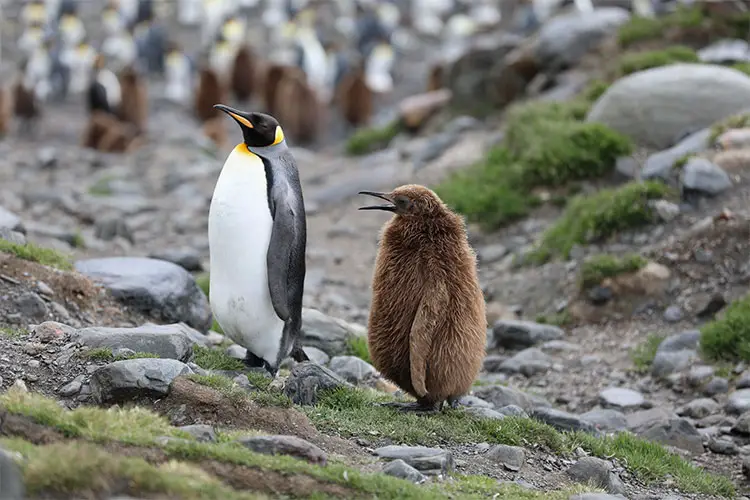
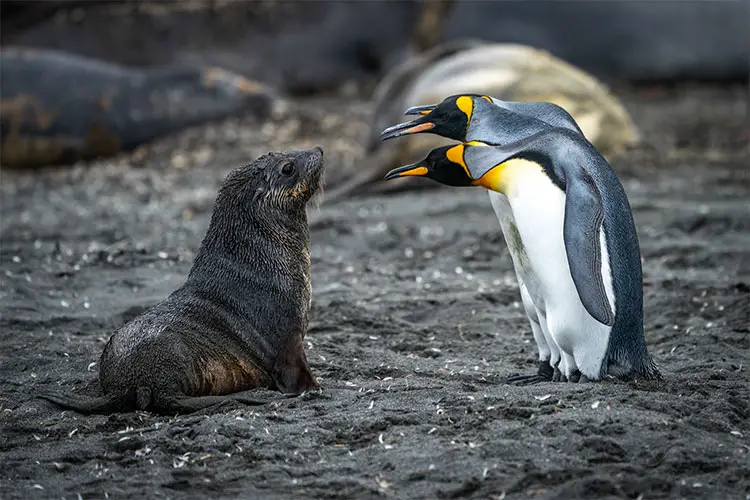
Left – Mother King penguin with chick | Unsplash: Martin Wettstein & Right – King Penguins and an inquisitive seal pup on a beach in South Georgia | Unsplash: Rod Long
Forest
Where tundra is characterized by a complete lack of trees, forest biomes are defined by them. These densely vegetated areas make up around 40% of the world’s landmass and are split into 3 main types; boreal, temperate & tropical. These classifications can be fairly accurately defined by latitude; a band of boreal forest—known as the Taiga belt—sits beneath the tundra followed by a strip of temperate forest further south. Tropical forests sit in the world’s equatorial regions and make up the largest portion of forest—around 45%. Forest is then further defined by precipitation; tropical rainforest and temperate rainforest, for example, receive much more precipitation than tropical dry forest or dry temperate forest. It’s complicated! It should come as no surprise then that the animal life found in the forest biome is equally as varied.
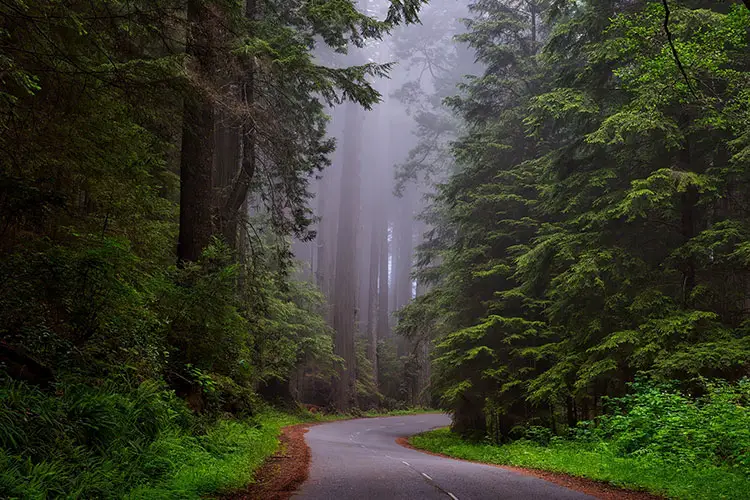
Boreal Forest
Also known as taiga or snow forest, this band of dark green trees sits between the Arctic tundra in the north and the temperate forests further south. The temperatures here are still cold but the lack of permafrost and increased precipitation allow for the growth of these spectacular forests. The trees in this biome are mostly coniferous; instead of leaves and flowers, they bear needles and cones, which do not shed at the end of the summer—hence their evergreen moniker. In a similar fashion to the robust vegetation of the taiga, the animals here are also a hardy bunch dressed head to toe in thick fur to tackle the long winter months.
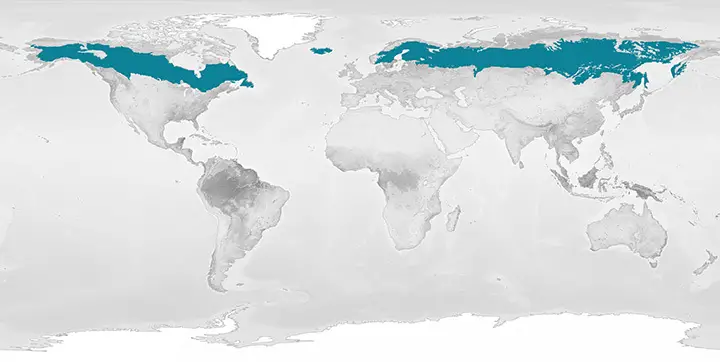
Boreal Forest Facts
- Characteristics: Cold, low precipitation and coniferous trees
- Temperature Range: -40°C / -40°F to 20°C / 68°F
- Precipitation: 300 to 900 millimeters / 12 to 35 inches of rain per year
- Vegetation: Spruces, pines and firs
The primary consumers of the Boreal forest are dominated by species of deer including moose, reindeer, elk and roe deer. Moose are located almost entirely in the taiga, their range extending only slightly further south into temperate forests where they struggle with the heat. Wood bison—not to be confused with plains bison who live further south—are found in the forests of northwestern Canada and Alaska. These gigantic creatures can reach almost 1200kg / 2600lbs and stand up to 3.35m / 11ft tall making them the largest terrestrial animal in North America.
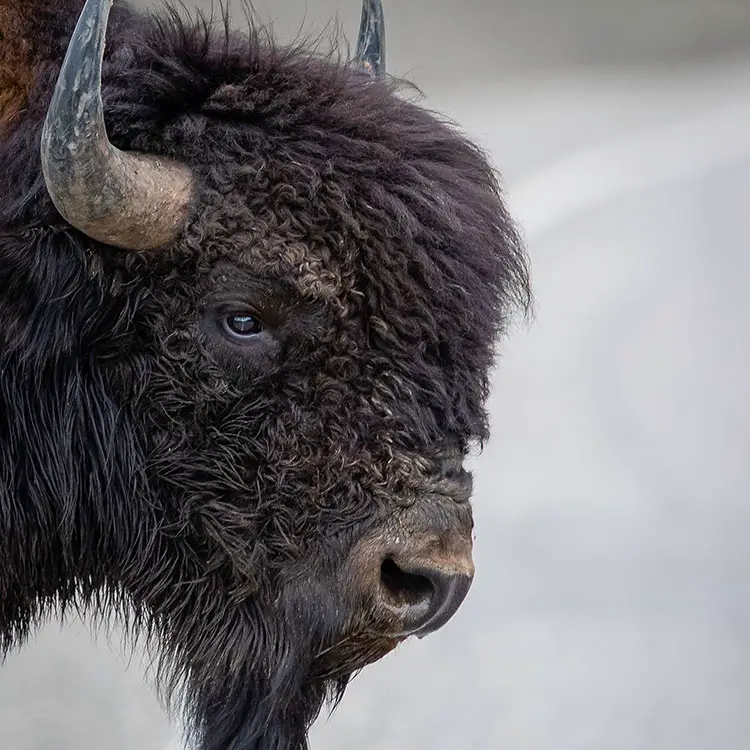
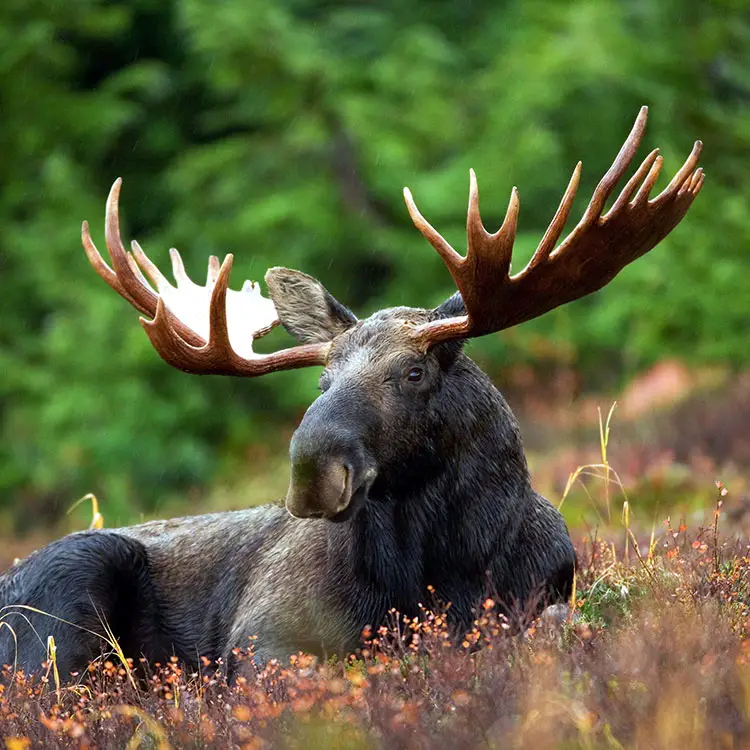
Left – Wood Bison portrait | Unsplash: Pete Nuij & Right – Bull Moose | Pixabay: David Mark
Although rare, by far the most terrifying creature to roam the snow-ladened forests of the taiga is the Amur tiger. Also known as the Siberian tiger, these incredible predators are found exclusively in far eastern Russia and are the largest of the felids, weighing upwards of 300 kg / 660 lbs. Another family of wild cats adept at traversing the snowy terrain are Lynx, of which two species inhabit boreal forests; the Eurasian Lynx who occupy much of northern Eurasia and the Canada Lynx who roam the forests of Canada and Alaska in search of snowshoe hares. Brown bears are also found in this biome throughout much of Canada, Alaska and northern Eurasia and have even been known to battle the aforementioned Amur tiger from time to time.
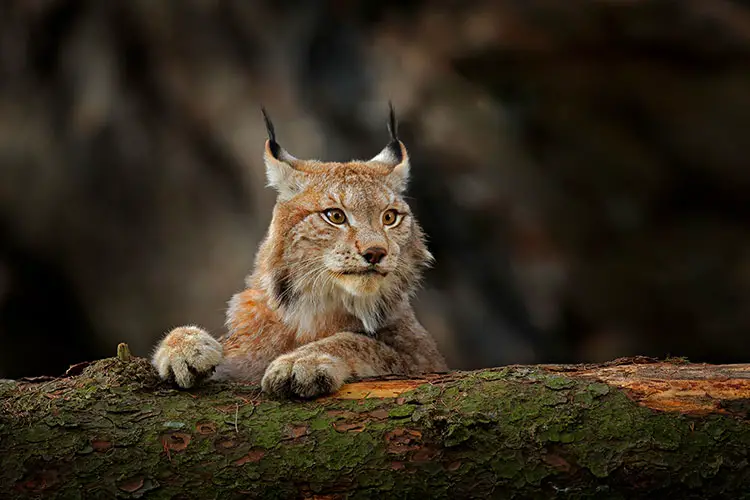
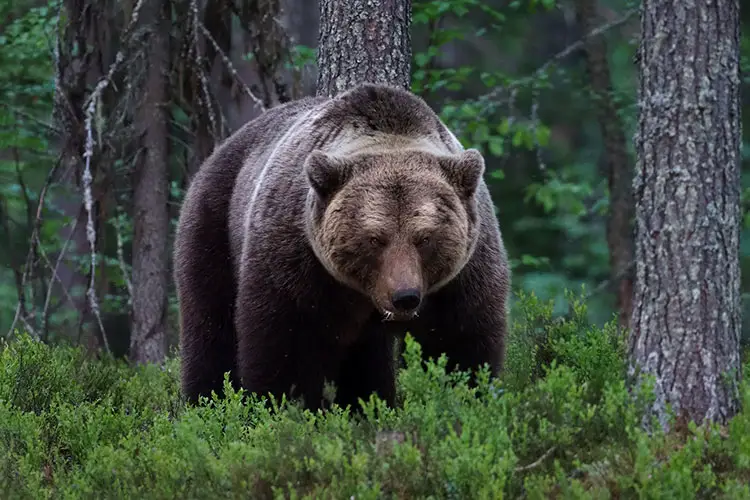
Left – Eurasian lynx & Right – Brown Bear in Viiksimo, Finland | Frank Vassen on Flickr
There are many small mammals that thrive in this biome including beavers, martens, otters, stoats, weasels and mink. The second largest of the order, Rodentia, beavers are semi-aquatic mammals who build dams with vegetation and rocks to provide shelter. These dams are so pivotal to the eco-systems in which they exist, beavers are thought of as a keystone species—those who have a disproportionate effect on their environment. Along with otters, weasels and mink, stoats are members of the Mustelidae family; they are voracious predators of the taiga known to decimate populations of birds and small mammals such as rabbits.
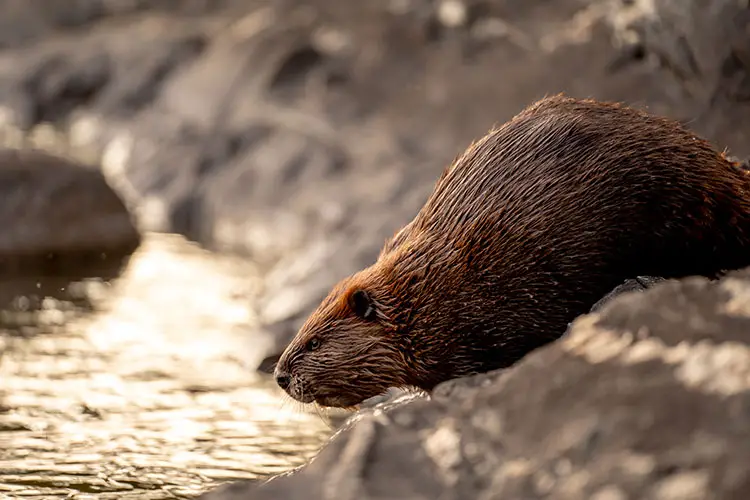
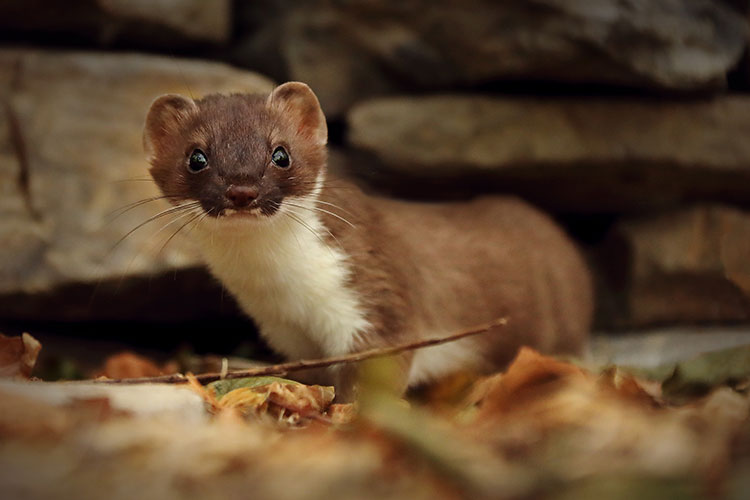
Left – Beaver in Voyageurs National Park, Northern Minnesota | Unsplash: Tim Umphreys & Right – Stoat | Flickr: Charlie Marshall
There are roughly 32,000 species of insects in Canada’s boreal forests alone, which make for quite the feast for both the taiga’s permanent aerial residents and the flocks of migratory birds who visit in the summer. Some of the most beautiful birds here include great grey owls, great horned owls, ptarmigans, woodpeckers and the Canada jay. The black-backed woodpecker—whose Latin name means northern or arctic—breeds in the boreal forest and can be found drilling their nests into trees or hunting for beetles. Although there are a few species found in the taiga—such as the wood frog and the boreal chorus frog—amphibians and reptiles do not fare well in this frigid climate.
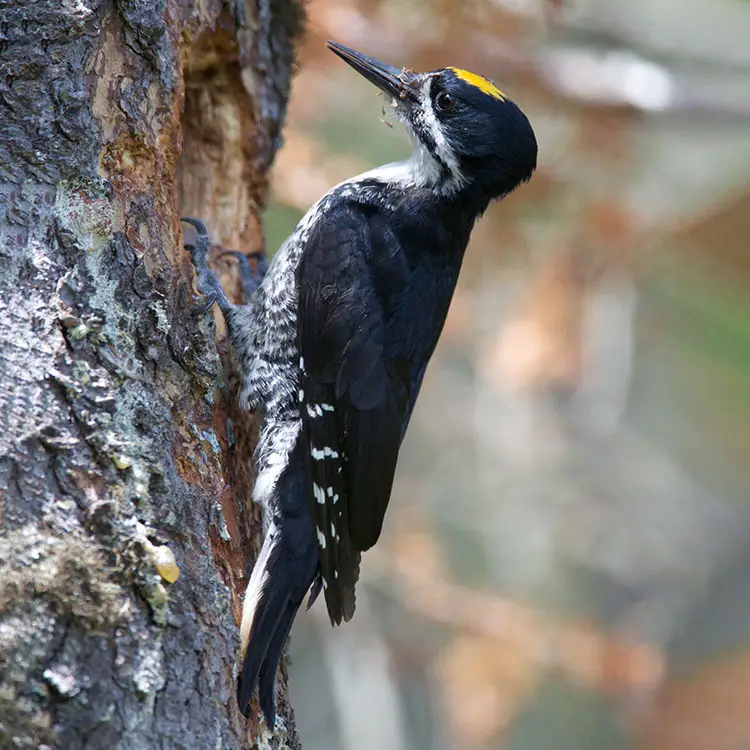
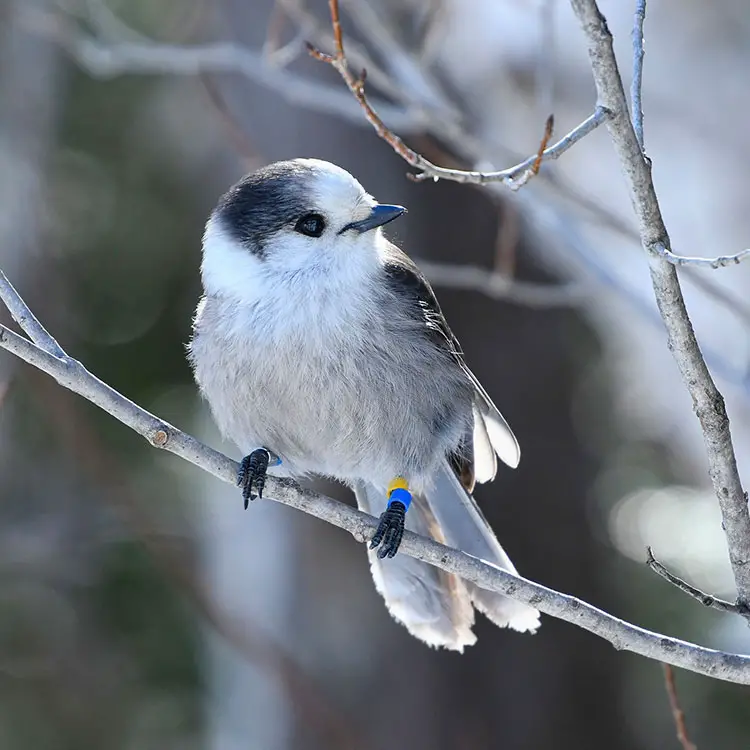
Left – Black-backed woodpecker, Brunswick, Vermont | WikiCommons: U.S. Fish and Wildlife Service & Right – Canada jay, Algonquin Provincial Park, Ontario | WikiCommons: Mykola Swarnyk
Temperate Forest
The word temperate denotes a mild climate, not too hot, not too cold. Kind of like baby bear’s porridge in Goldilocks… juuuust right! The vast majority of the world’s temperate forests are found in North America and Eurasia, however, there are also areas of this biome in southern South America, southern Africa and Australasia, which provide some interesting diversity. This biome is made up of mostly deciduous trees, which bear large leaves that turn red, yellow, and orange in the autumn before shedding to the ground and regrowing in spring. The trees here are mostly deciduous and bear large leaves, which famously turn red, yellow, and orange in the autumn before shedding to the ground and regrowing in spring. Wildflowers brighten up the forest floor, which is covered in mosses, ferns and other small plants. There are noticeably fewer large mammals in temperate forests but, thanks to an increase in precipitation and milder temperatures, all kinds of amphibians and reptiles finally come out to play.
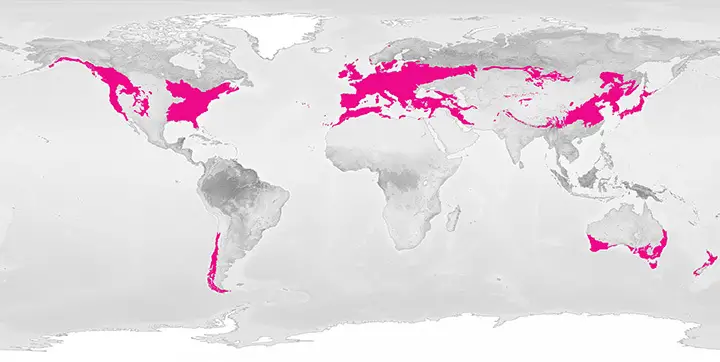
Temperate Forest Facts
- Characteristics: Mild, medium precipitation and deciduous trees
- Temperature Range: -30°C / -22°F to 30°C / 86°F
- Precipitation: 750 to 1,500 millimeters / 30 to 59 inches of rain per year
- Vegetation: Birches, oaks, maples, mosses, shrubs & perennial herbs
One of the most common families of primary consumers in this biome are deer; moose will venture into temperate forests but smaller species such as white-tailed, red and sika deer are much more common. Stalking the deer are large predators such as cougars and timber wolves. Cougars in particular have a massive range spanning multiple biomes from the temperate forests of North America to the tropical forests and grasslands of South America. Bobcats are another feline found in this biome; a smaller relative of the Canadian and Eurasian Lynx. Black bears, who live further south than their brown-pelaged cousins, are also present in the temperate forest where they spend a great deal of time snacking on berries and tree shrubs.
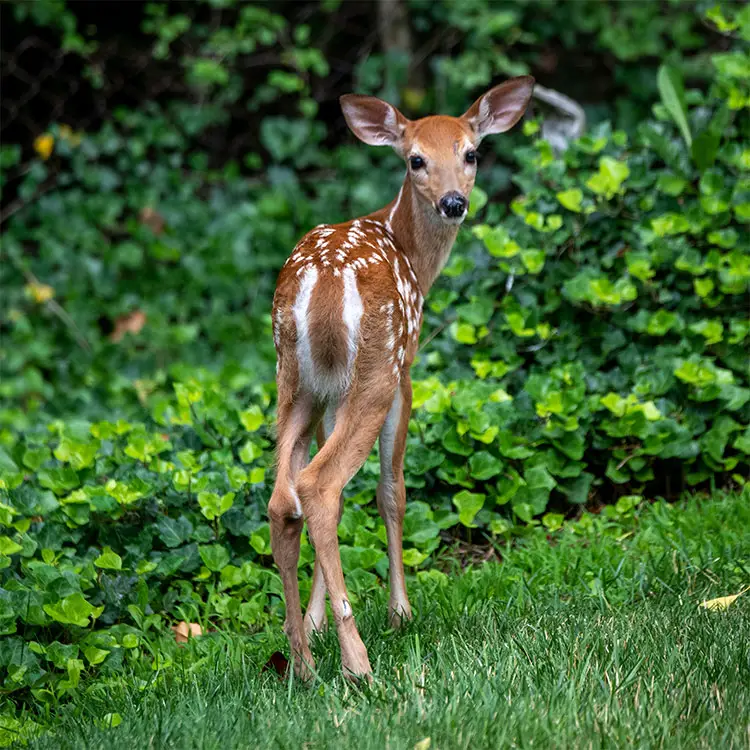
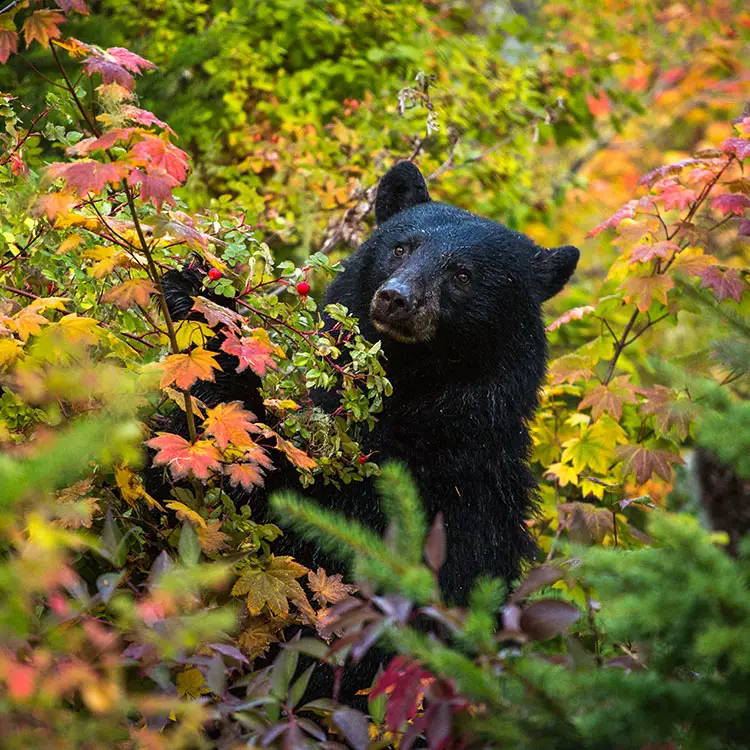
Left – White-tailed deer fawn | Unsplash: Robert Woeger & Right – Adult black bear eating berries
Most of the mammals in the temperate forest biome are much smaller and can be found feasting on leaves and nuts in the trees or scurrying around on the forest floor. Badgers, hedgehogs and tree squirrels are common in the forests of Europe while chipmunks and racoons are found in North America. Similar to the den of a fox, badgers live underground in networks of tunnels called sets. They spend their days digging for earthworms and various insects and are also known to hunt other small mammals, birds and amphibians. Tree squirrels and chipmunks are from the same family, Sciuridae, and are well-known for gnawing on nuts and seeds which they collect and bury in the ground.
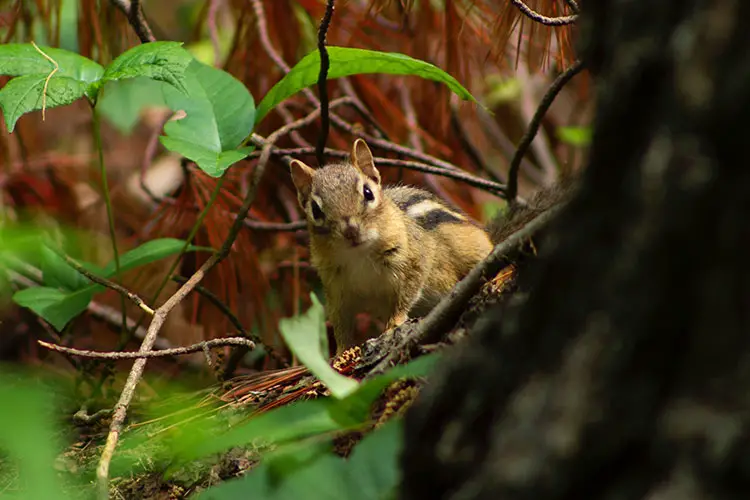
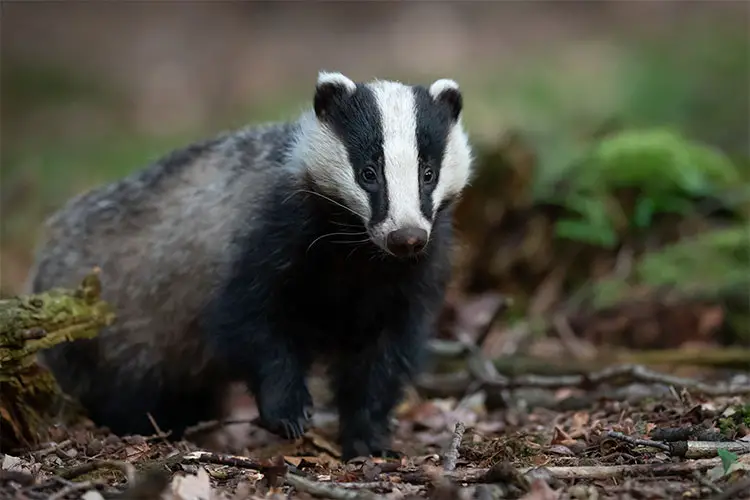
Left – Chipmunk | Unsplash: Victoria Bragg & Right – Adult badger | Unsplash: Vincent van Zalinge
Red Pandas are arboreal mammals endemic to the temperate forest regions of the Himalayas; they are unrelated to the giant panda but also feed mostly on bamboo—although, being a member of Carnivora, will also hunt small mammals and birds. Koalas are found solely on the west coast of Australia and their range covers both temperate and tropical forests. When they are not sleeping (20+ hours per day!), they spend their day slowly traversing the forest canopy, feasting mainly on the leaves of eucalyptus trees.
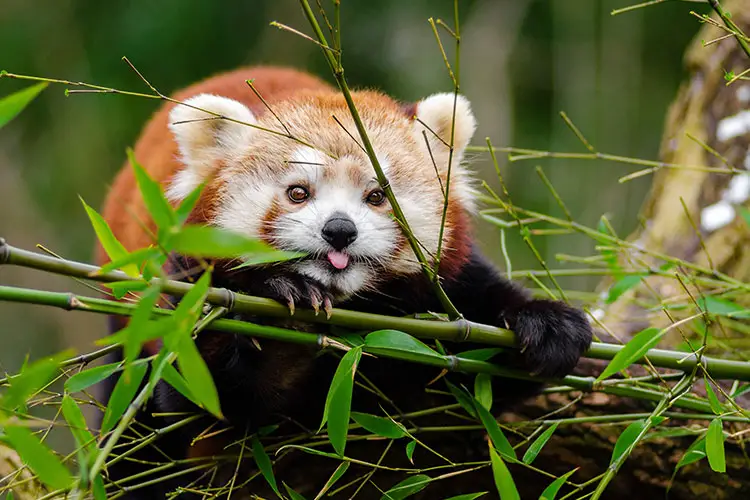
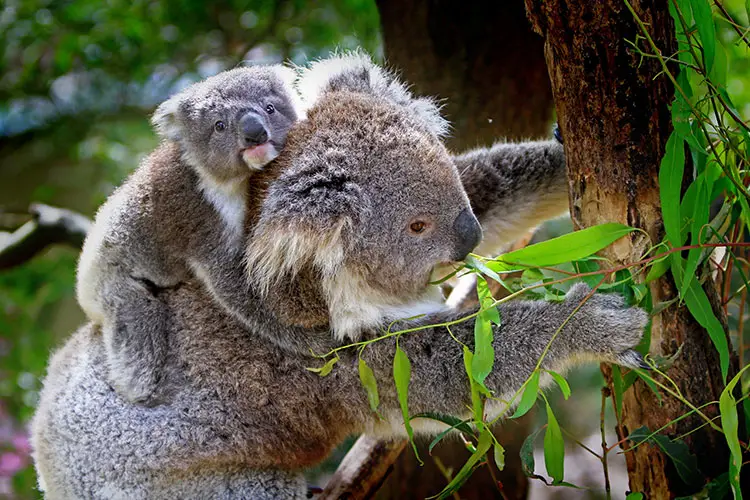
Left – Red panda eating bamboo | Pixabay: Pexels & Right – Mother koala and joey | Pixabay: Holger Detje
The birds of the temperate forest are plentiful and range from pigeons, robins and tits to jays, warblers and hawks. Although pigeons are most well-known for eating bread in city parks (think Home Alone 2) in fact, the pigeon family, Columbidae, is one of the most varied bird families in the world and is found on every continent with the exception of Antarctica. Robins are inquisitive birds who exhibit a beautiful red plumage on their chest and face; much like badgers, they spend their day hunting for earthworms and both males and females can be heard warbling to each other before sunrise during the breeding season.
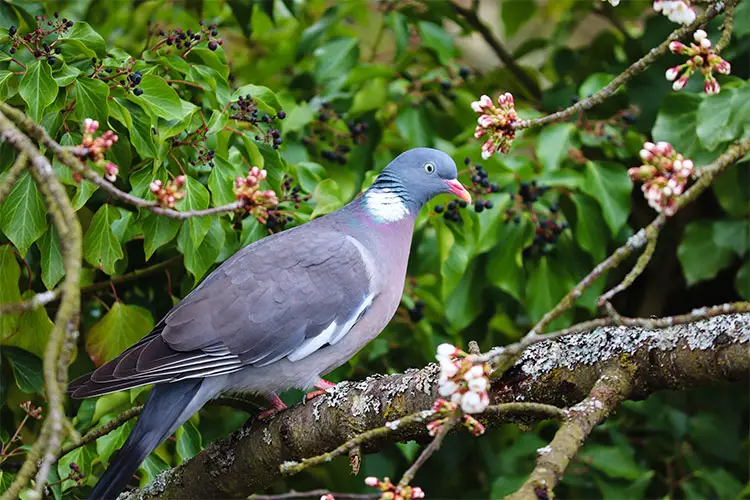
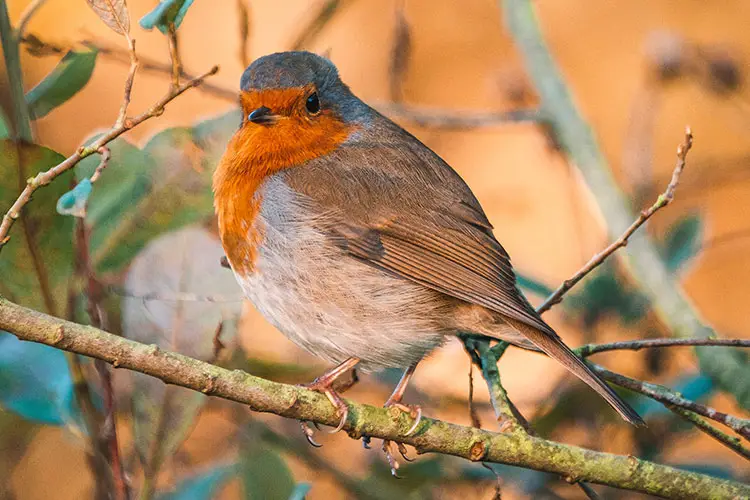
Left – Wood Pigeon perched in a cherry tree | Pixabay: Manfred Richter & Right – Robin | Unsplash: Alfred Kenneally
Garter snakes are found throughout much of North America where they hunt amphibians, lizards, rodents and even slugs! Insects are also plentiful in the temperate forest biome; many species of the order Lepidoptera use the underside of leaves to lay their eggs, which transform into caterpillars and eventually blossom into multicoloured butterflies and moths. Bees, wasps and cicadas are among some of the many other insects who call this biome their home. In addition, thanks to increased precipitation and milder temperatures that prevent freezing for most of the year, amphibians such as toads, frogs and salamanders enjoy the damp forest floor.
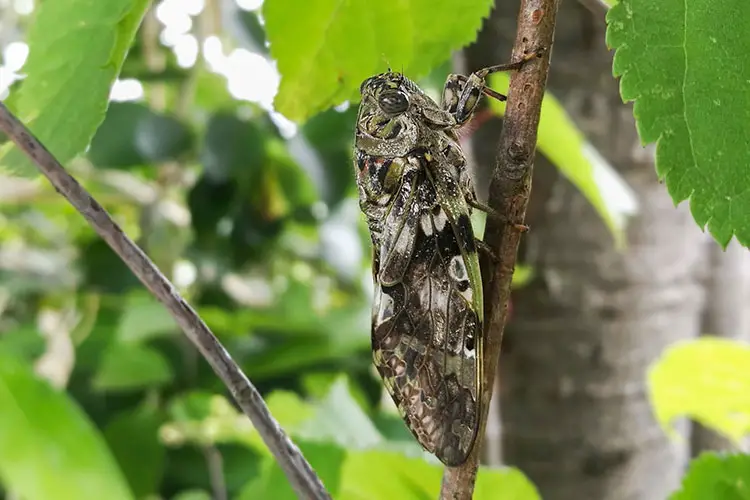
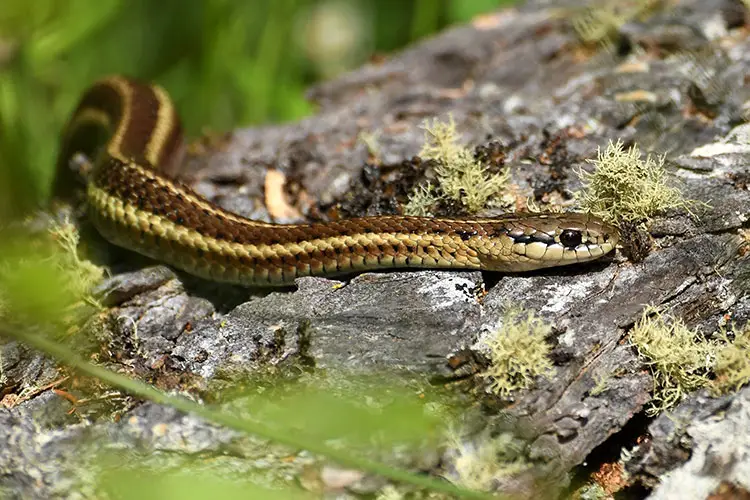
Left – Cicada in the forests of Japan | Pixabay: Shigeki Umeta & Right – Garter Snake | Pixabay: Nature-Pix
Tropical Forest AKA Rainforest
Realistically, the animals of the rainforest could be a completely separate article; this biome is famous for its biodiversity. In fact, the world’s top three most biodiverse countries—Brazil, Colombia and Indonesia—all contain vast swaths of rainforest. These hubs of biodiversity receive the most precipitation of any biome and can be broken down into several layers. The emergent layer contains the tops of the tallest trees such as kapok, which grows upwards of 200ft. Beneath lies the canopy layer—containing most of the wildlife—home to custard apple trees (which sounds delicious!) and the cashew-bearing Anacardium Excelsum. Due to the density of the canopy layer, both the understory layer and the forest floor are largely starved of light and therefore contain much smaller (but no less delicious!) vegetation. The understory layer includes banana, fig and palm trees, while the forest floor is coated in ferns, vines and flowers such as orchids.
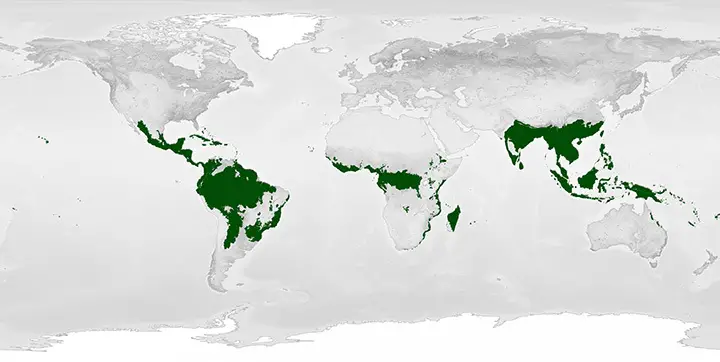
Tropical Forest Facts
- Characteristics: Warm, very high precipitation & tall, dense foliage
- Temperature Range: 20°C / 68°F to 25°C / 77°F
- Precipitation: 2,000 to 10,000 millimeters / 79 to 394 inches of rain per year
- Vegetation: Kapok, banana & fig trees, vines, ferns and flowers
Both tigers and jaguars are well-known for calling the rainforest their home. Tigers are located in Asia, in the tropical forests of countries like India, Myanmar and Indonesia, whereas jaguars are located in the Americas, from the jungles of Mexico to the Brazilian Amazon. Jaguars are located in the Americas, from the jungles of Mexico to Brazil. These incredible felines are terrifyingly agile and are known to hunt caiman on the banks of the Amazon. The world’s largest snake, the anaconda—measuring up to 10m / 30ft and weighing up to a staggering 250kg / 550 lbs!—is also known to hunt caiman as well as wild pigs, deer, smaller mammals and birds.
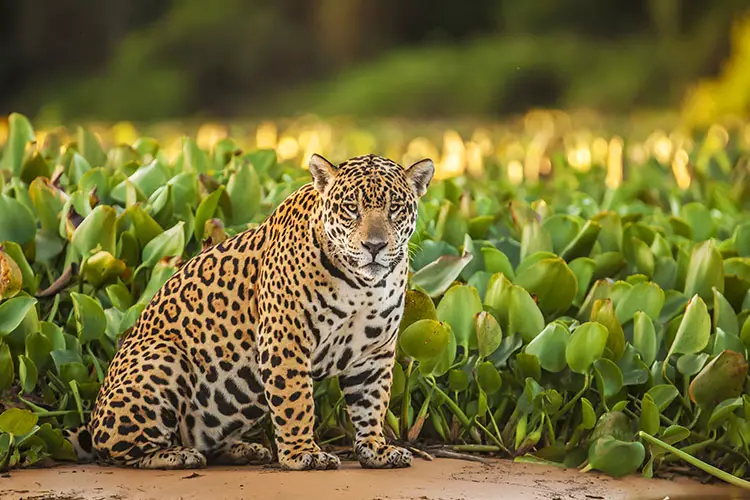
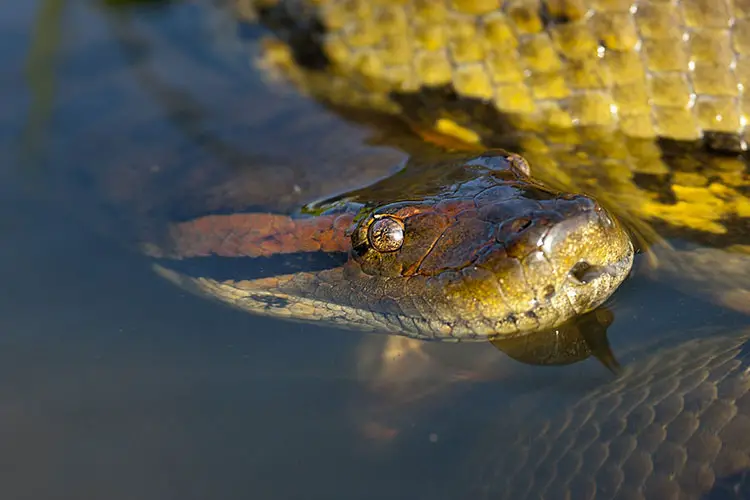
Left – Jaguar in the Brazilian Amazon & Right – Anaconda lurking in the water
Although not exclusive to the rainforest, the range of the primate family is also generally found between the Tropic of Cancer and the Tropic of Capricorn. Of the great apes—our closest relatives—chimpanzees and gorillas inhabit the rainforests of Central Africa, whereas the docile Orangutan is found on the islands of Borneo and Sumatra. The tropical forests of the Americas are home to New World Monkeys, including capuchins, tamarins and howler monkeys. Primates feed on plant matter such as fruits, leaves and nuts as well as other animals including small birds, rodents and reptiles.
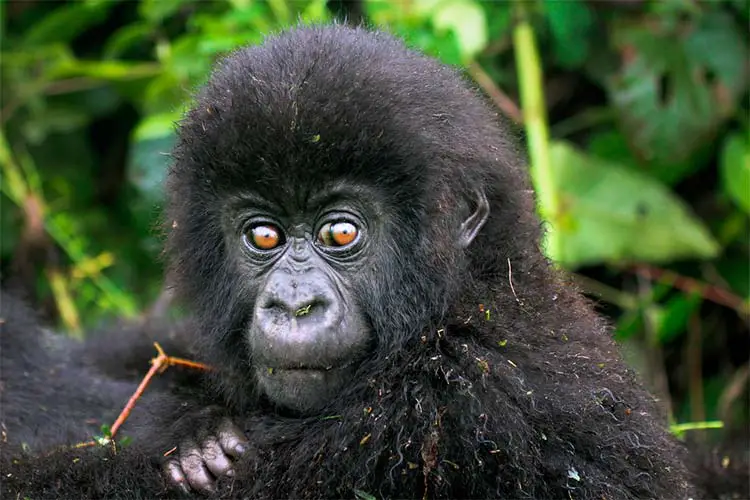
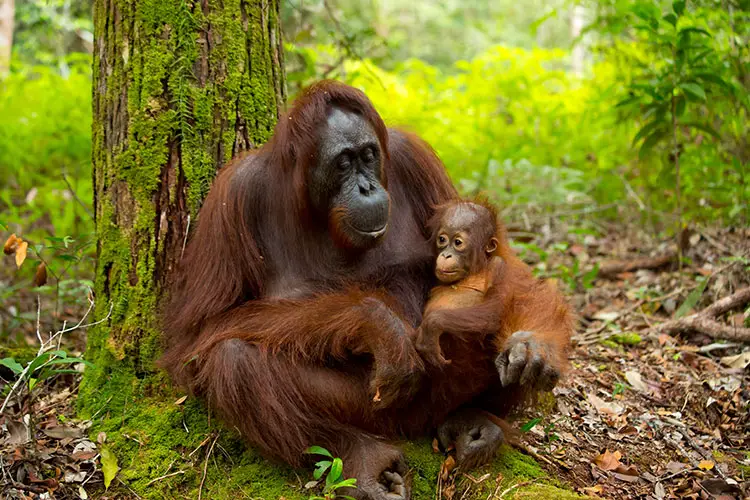
Left – Baby gorilla in Congo & Right – Capuchin in the Pantanal, Brazil
The primary consumers of the rainforest are an odd-looking bunch! Anteaters, sloths, wild pigs and tapir roam the forest floor in search of sustenance. Anteaters and sloths are both from the order Pilosa—from the Latin word pellis, which means hairy—and are found only in the Americas. Sloths travel at excruciatingly slow speeds of up to 4m / 13ft per minute, which oddly enough protects them from predators such as jaguars who depend on movement to spot prey. Tapirs are another odd-looking mammal who live in the tropical forests of the Americas, they eat fruits, leaves and berries and are known to eat up to 40kg / 85lbs of vegetation in a single day.
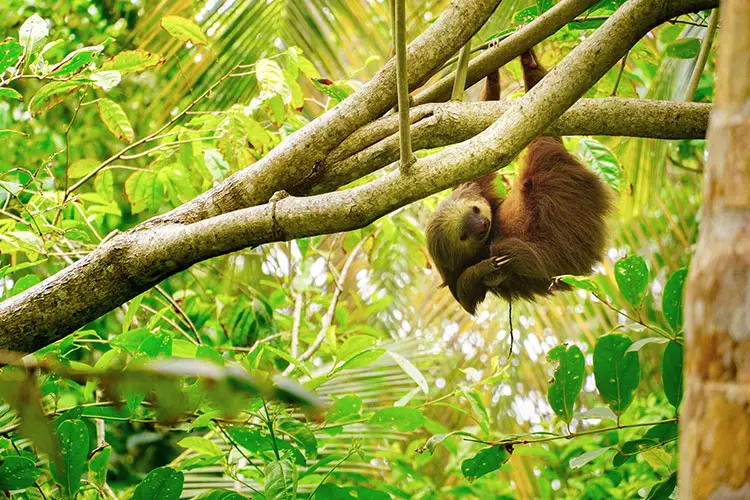
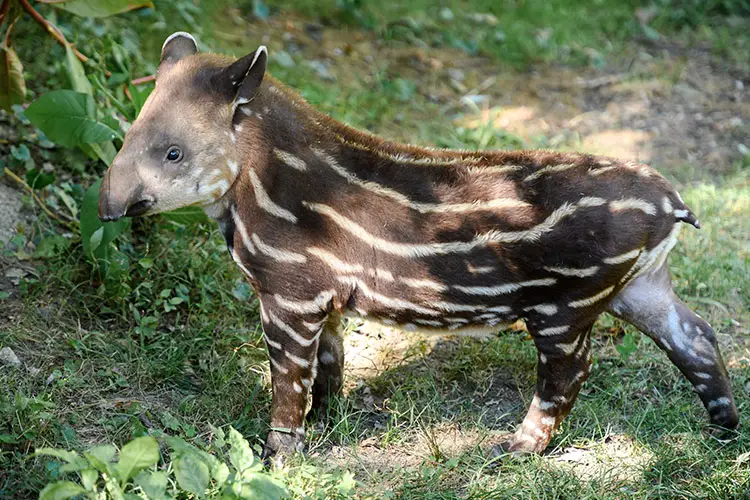
Left – Sloth hanging from a tree in Costa Rica | Unsplash: Adrián Valverde & Right – Tapir calf with stripes | Flickr: Eric Kilby
Aside from beautiful orchids and other flowering plants, birds bring colour to the rainforests, often found in exotic blues, reds and yellows. Parrots are one of the most widespread and varied families of birds, ranging from macaws in the Americas, cockatoos in Australasia and lovebirds in Africa. Macaws are a group of New World parrots who are famed for their bright plumage; the rather unimaginatively named blue and yellow macaw can live up to 35 years in the wild and display a spectacular blue back atop a yellow breast and underwings. Lovebirds are a group of Old World parrots known to form strong monogamous relationships between mating pairs. They have green plumage on their body with the facial plumage and beak varying in colour between species.
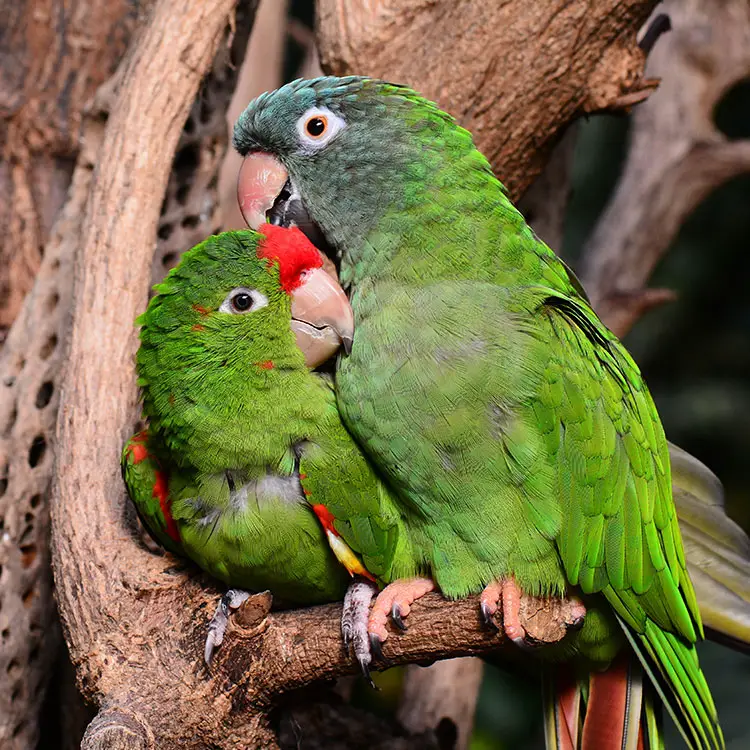
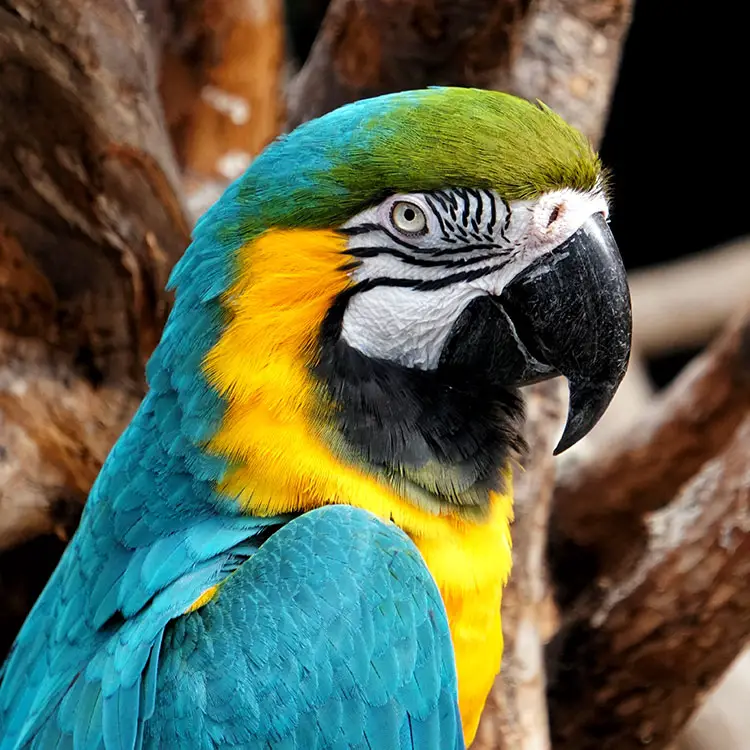
Left – Mating pair of lovebirds | Pixabay: Jondolar Schnurr & Right – Blue and yellow macaw | Unsplash: Zachary Spears
While many of the other biomes we have discussed are not overly hospitable for reptiles and amphibians, these creatures thrive in the tropical forest biome. Snakes are perhaps the most well-known reptile in the rainforest and can kill their prey in one of two ways. Boas—including the aforementioned anaconda—and pythons will initially bite their prey but kill by constriction. Other species of snake kill their prey with potent venom including the green mamba and various members of the bush viper genus. Many frogs within this biome are also poisonous, although the secretion of their venom is used as a self-defence mechanism. Poisoned dart frogs are a family of amphibians found in Central and South America, often displaying vibrant coloured patterns, used to warn predators of their venomous capabilities.
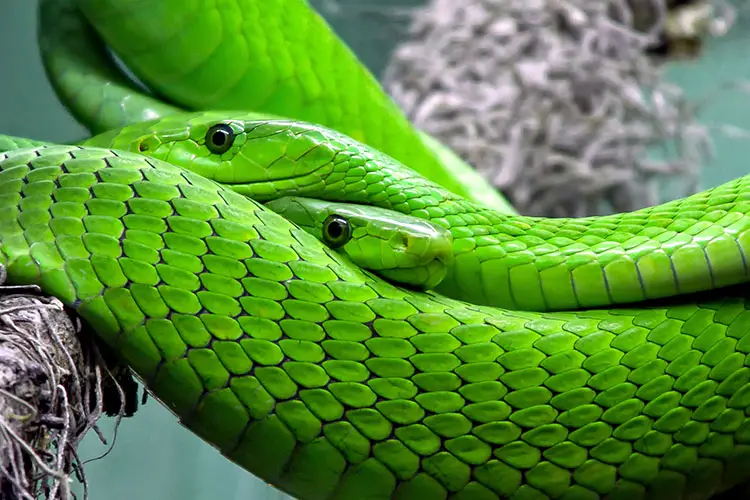
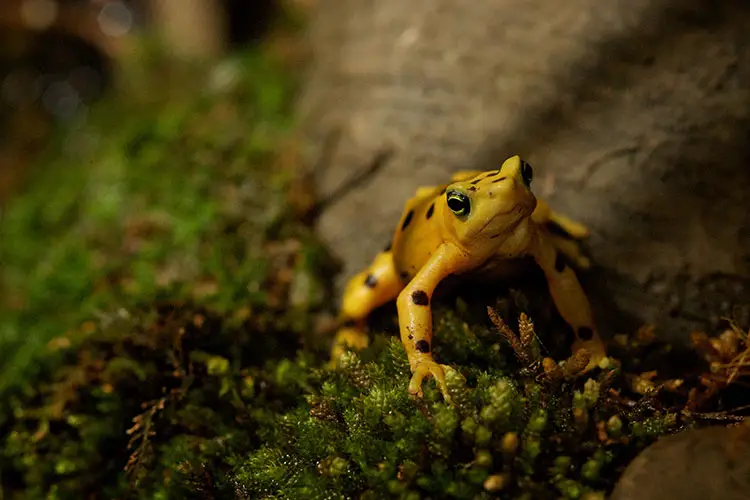
Left – Aww! Even green mambas can look romantic! Pixabay: Foto-Rabe & Right: Poison dart frog | Flickr: Keith Kissel
Insects are another group of animals that flourish in the rainforest. Entire armies of ants are known to roam the forest floor, while swarms of bees make their nests higher up in the forest canopy. One of the most interesting insects of the tropical forest biome is the praying mantis, which actually refers to an entire family of mantises containing over 2,400 species. These insects are known to camouflage exceptionally well into their respective environments, a trait they use to ambush smaller unwitting insects. Butterflies are plentiful in this biome and are also found in a variety of colours and patterns. The black swordtail—also known as the mamba swordtail—is a particularly striking example found in the tropical forests of Africa.
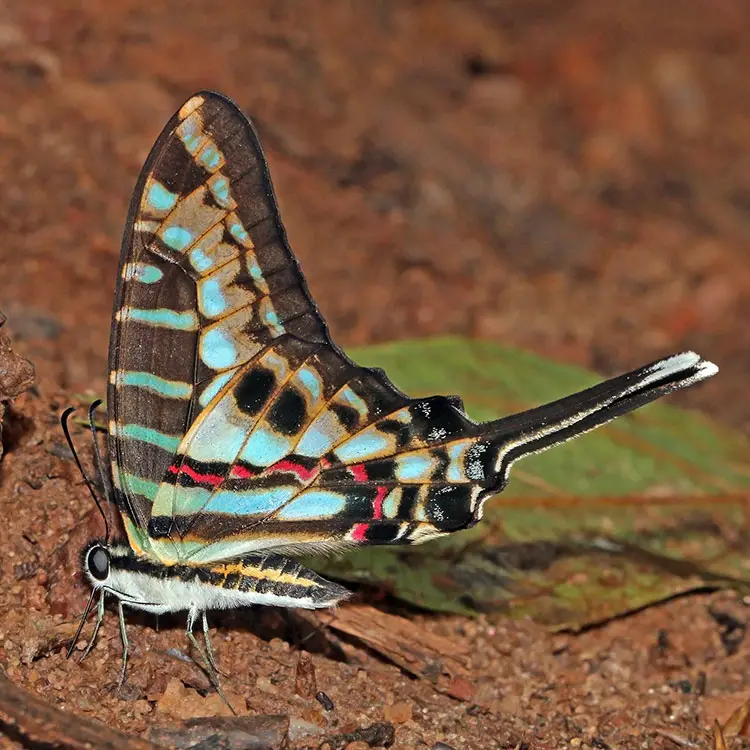
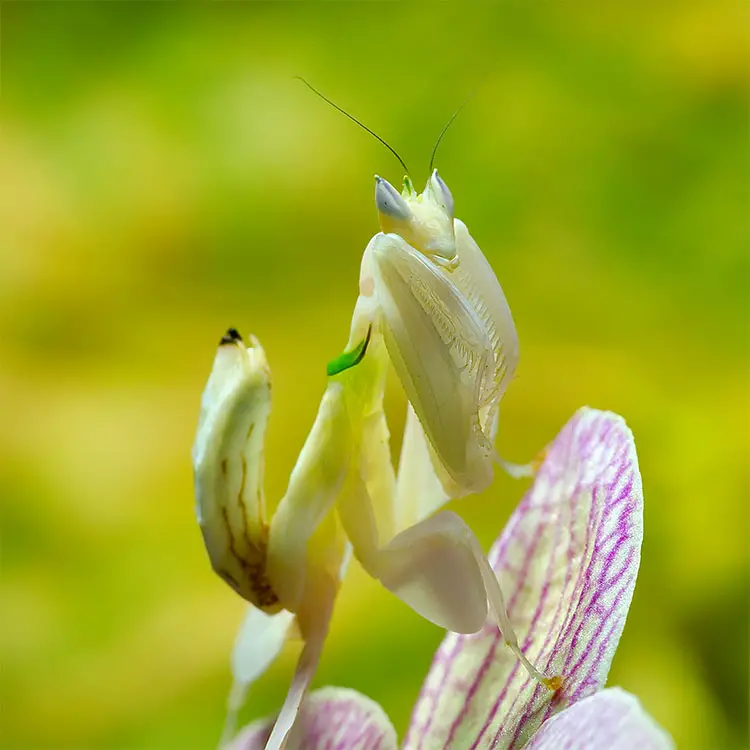
Left – Turquoise-spotted swallowtail, Bobiri Forest, Ghana | WikiCommons: Charles J. Sharp & Right – Malaysian orchid mantis | WikiCommons: Luc Viatour
Grassland
Grasslands are characterised by wide-open fertile plains filled with various species of grass. Although trees can grow here, they are individual—not grouped like forests—and are only present in tropical climates. Although the precipitation in the grassland biome is roughly the same as that of the boreal forest, summer droughts, fires and the grazing behaviour of its primary consumers prevent substantial vegetation growth. Grassland is found on every continent and accounts for roughly 25% of the world’s landmass. It is split into two main types: tropical and temperate, both of which sit at around the same latitude as their similarly named forested counterparts.
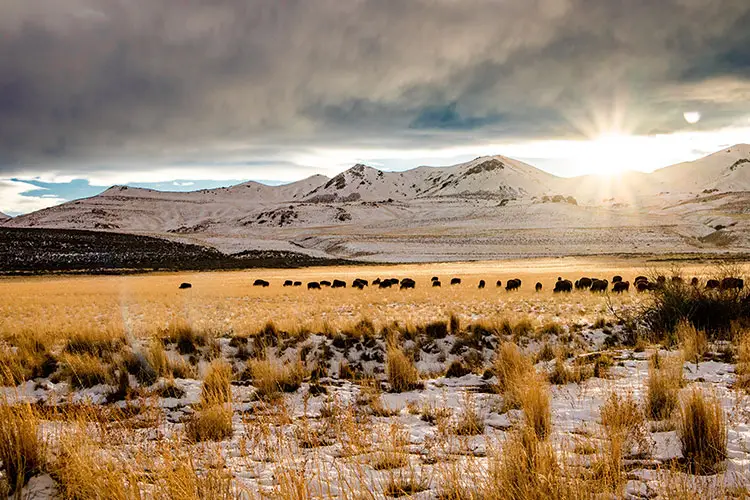
Tropical Grassland AKA Savanna
When I think of the savanna, I envision Africa; herds of wildebeest and zebra trekking from the Serengeti to the Masai Mara while dodging lions and crocodiles. However, tropical grassland is also found throughout South America, Australia and as far north as Mexico. The vegetation here is more substantial than temperate grassland but less so than forested areas. NASA refers to this biome as “shrubland”, which includes chaparral, woodland and savanna. The fauna of the African savanna makes up perhaps the most sought after animal experience on the planet: the safari. Although lions, leopards, elephants, wildebeest and rhinos are on the bucket list for most safari enthusiasts, the list of savanna animals is breathtaking and contains so much more than the Big 5.
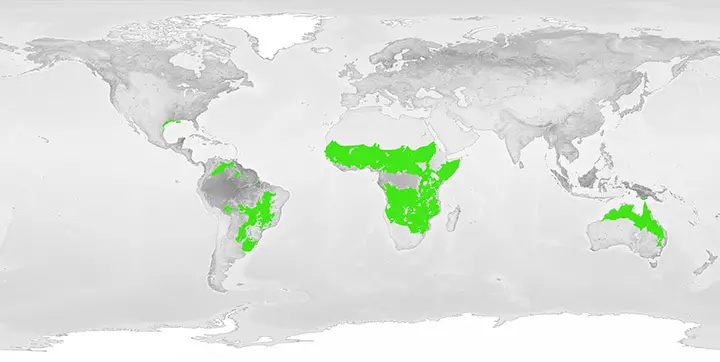
Tropical Grassland Facts
- Characteristics: Hot, medium precipitation, lots of shrubs and herbs
- Temperature Range: -1 °C / 30°F to 38°C / 100°F
- Precipitation: 200 to 1,000 millimeters / 8 to 40 inches of rain per year
- Vegetation: Small plants such as herbs, shrubs and grasses
The savanna is a striking yet brutal place. Predators include prides of lions and coalitions of cheetahs—the only two species of cat known to congregate in groups—hyenas, African wild dogs and gigantic crocodiles. African wild dogs are one of the furthest canine relatives to the domesticated dog—the closest being the grey wolf—and specialise in hunting antelopes. They have beautiful patched white, black and tan fur and are found mostly in sub-Saharan Africa. Interestingly, although not fully-fledged felids, hyenas are more closely related to cats than they are dogs. Clans of spotted hyenas, whose range almost exactly matches that of the African savanna, roam the tropical grasslands of Africa in search of prey, which they have been known to steal from other predators.
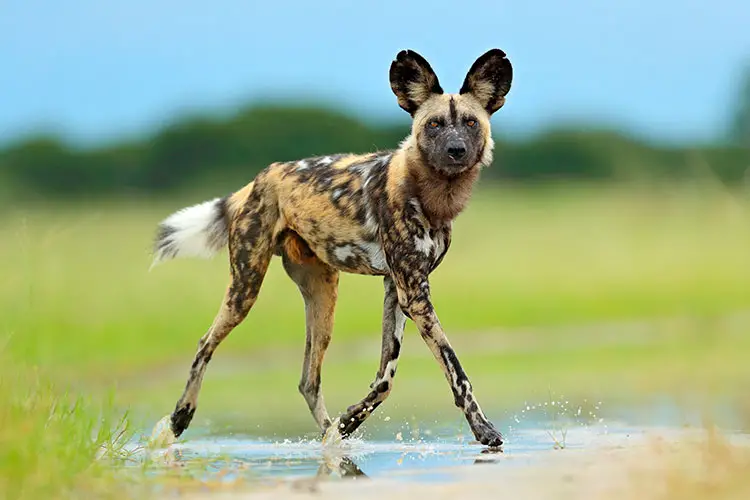
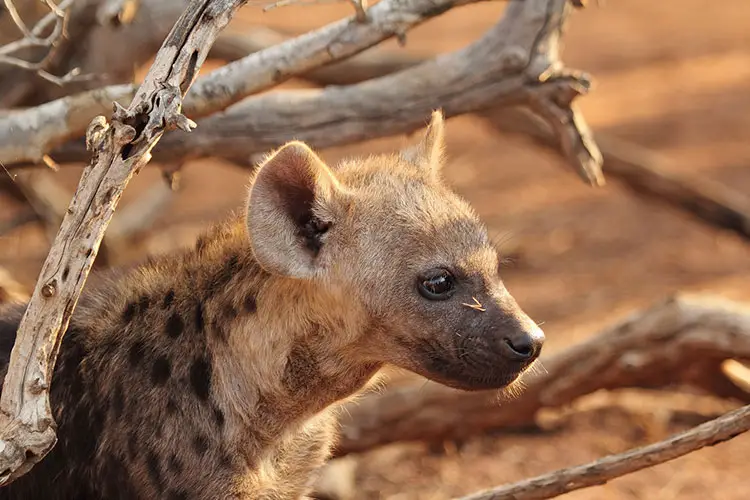
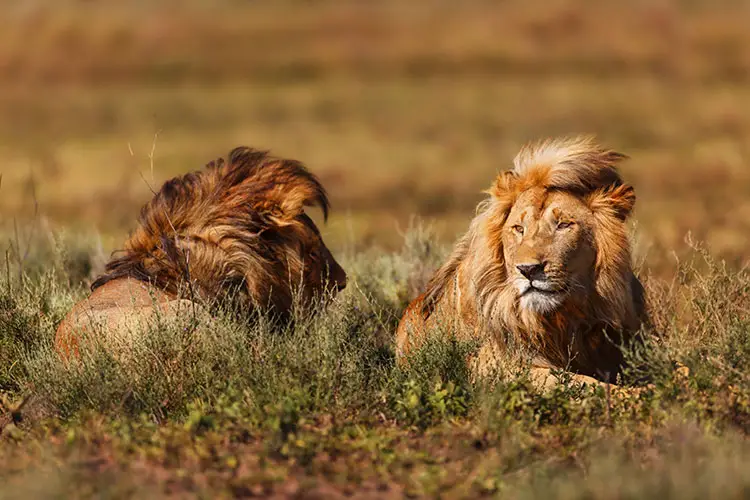
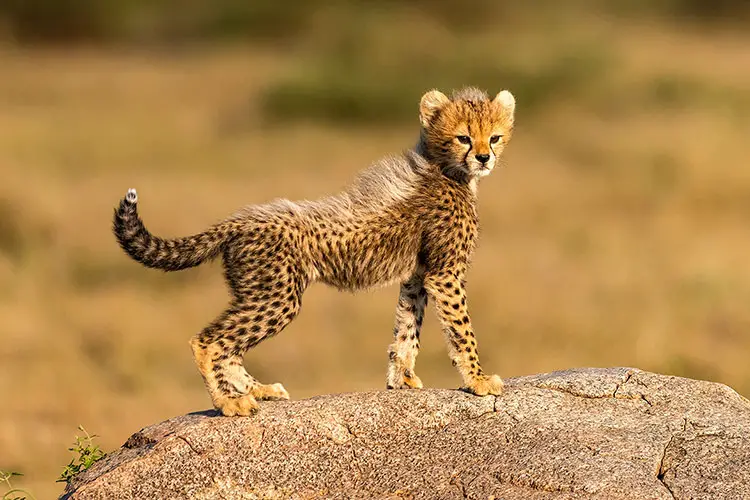
Top Left – African wild dog & Top Right – Hyena cub | Pixabay: Irma Bense & Bottom Left – Two male lions in Ngorongoro Conservation Area, Tanzania & Bottom Right – Cheetah Cub
The herbivores of the savanna are also among the most well-known in the world. Dazzles of zebra graze the wide-open African grasslands alongside buffalo, wildebeest, gazelles and giraffes. Unfortunately, rhinos are one of the most threatened animals in this biome; the two African species—the white and black rhinoceros—are listed as near threatened and critically endangered respectively. Elephants are the largest extant land mammal on earth, weighing up to 6.9 tonnes! Of the three species of elephant, the African bush elephant is most commonly seen on safari—the other two species being the smaller African forest elephant and the Asian elephant.
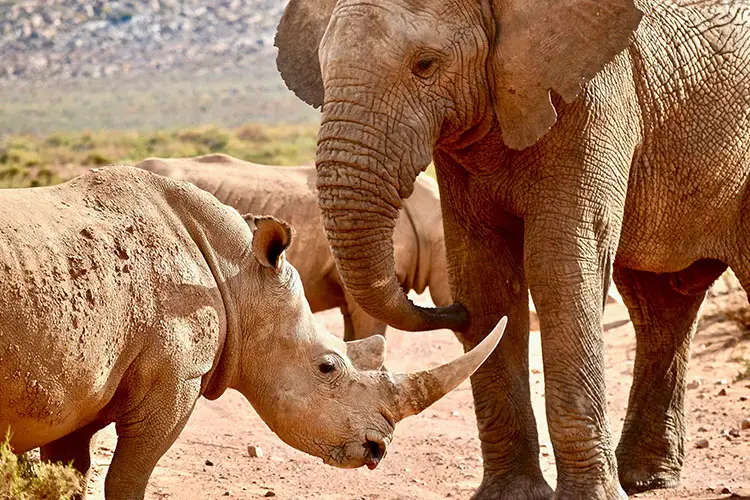
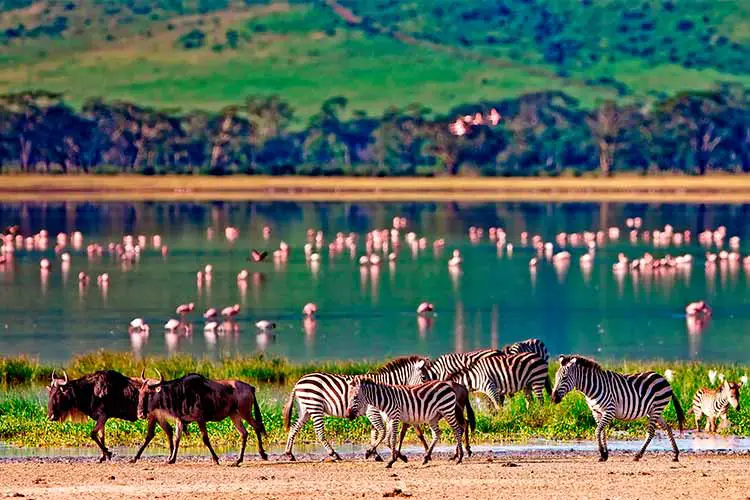
Left – Rhinos and Elephants at a watering hole in South Africa | Unsplash: Parsing Eye & Right – Zebra and wildebeest at Ngorongoro Crater, Tanzania
We’ll cover aquatic animals in more detail later on but it would be a shame to mention the reptiles of the savanna without including the Nile crocodile. Although not the largest crocodilian, Nile crocs can weigh up to 750kg / 1,650 lbs and are known to take down almost any mammal in this biome including, on occasion, the black rhino. The smaller reptiles of this biome include various species of lizard and snakes such as the African rock python and the black mamba. The second-longest venomous snake on earth—the longest being the king cobra—the black mamba is one of the most infamous snakes on the planet. They mainly hunt birds and small mammals such as rodents, bats and bushbabies.
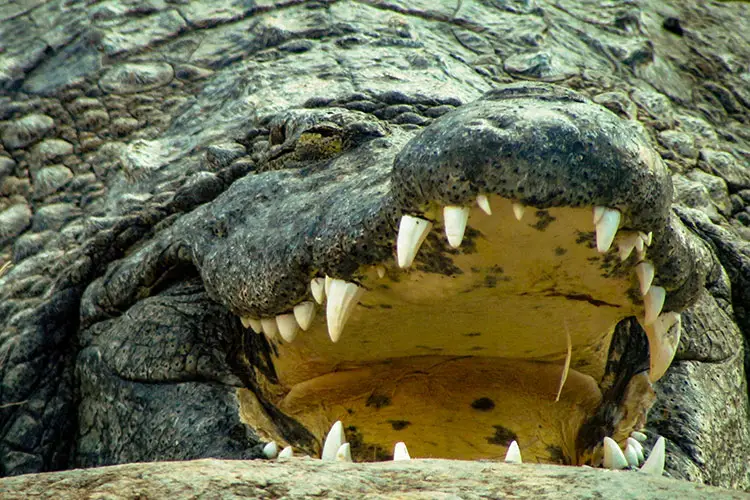
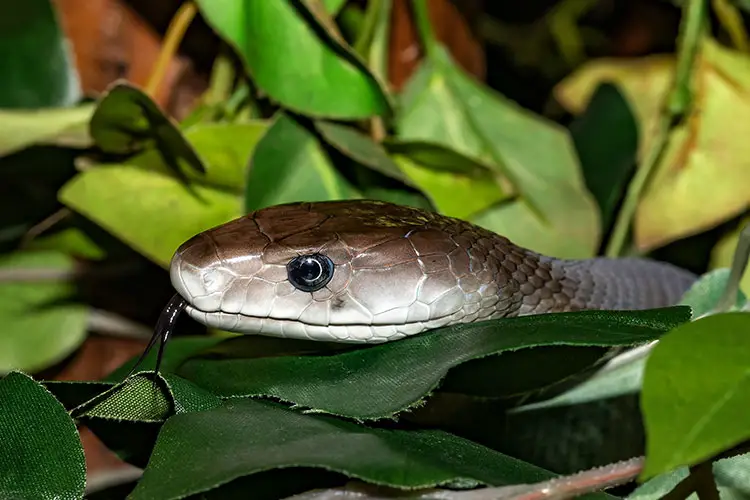
Left – The mouth of a large Nile crocodile | Unsplash: Joshua J. Cotten & Right – The venomous black mamba | Pixabay: Michael Kleinsasser
The large mammals here certainly garner the most attention but both insects and birds have noble representatives too. The tropical grasslands of Africa are home to over 1,000 species of termite and although these tiny insects would be difficult to spot on their own, their mounds can reach up to 9m / 29ft. Feasting on these termites are birds such as the Lilac-breasted roller, which has beautiful green, blue and purple plumage and can often be found in mating pairs. Larger birds of prey in this biome include vultures, buzzards and eagles, who soar over the open grassland in search of prey.
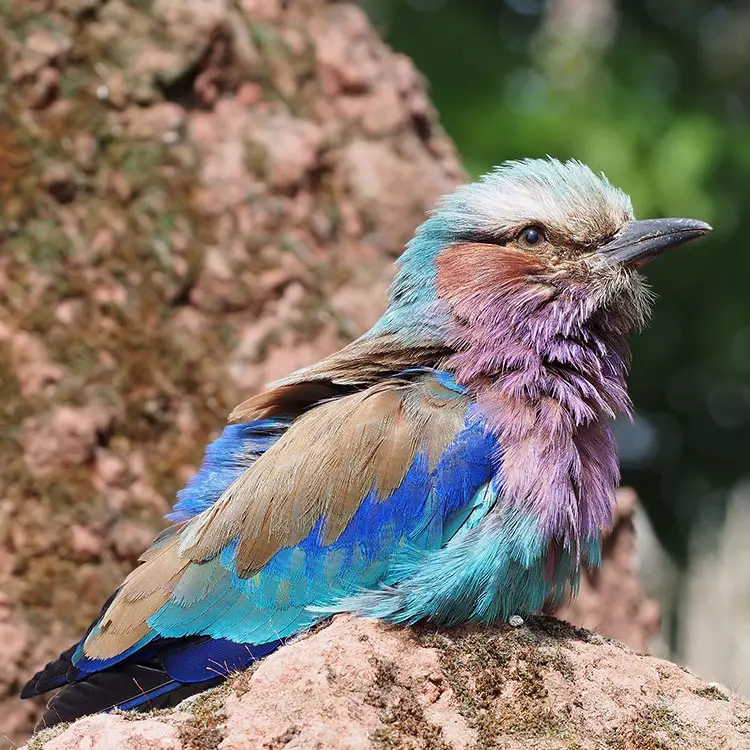
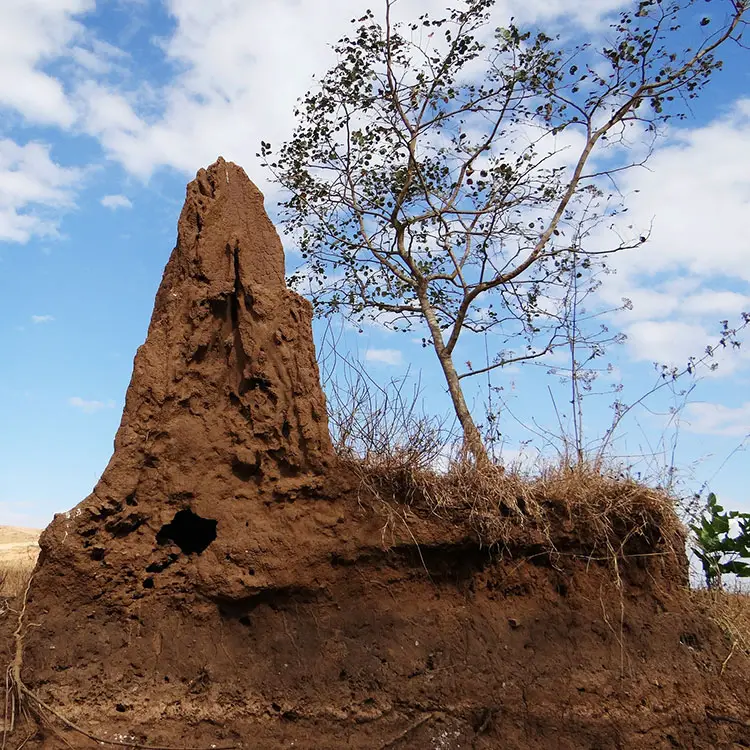
Left – Lilac-breasted roller | WikiCommons: Francis C. Franklin & Right – Termite Mound | Pixabay: Bishnu Sarangi
Although we’ve mostly discussed the tropical grasslands of Africa as that is where most of the most well-known animals from this biome are located, tropical grasslands are found in North America, South America and Australasia too. The fauna of the Australian savanna includes some of the most unique animals on the planet including kangaroos and emus. Indigenous to Australia and New Guinea, Kangaroos are the largest of the marsupial family and can reach speeds of up to 70km/h / 43mph, which is a little faster than an emu—the second largest bird in the world (I wonder if they race?!).
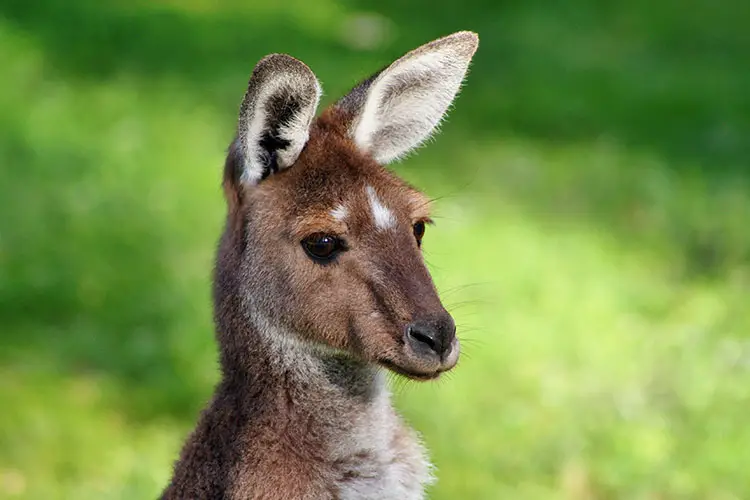
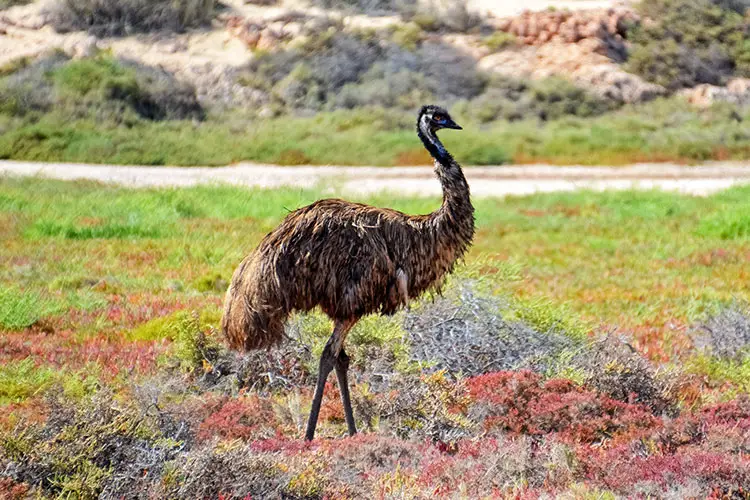
Left – Young grey kangaroo | Unsplash: Michael Waters & Right – The emu a relative to the African ostrich | Unsplash: Jeremy Zero
Temperate Grassland
Known as steppe in Asia, prairie in North America, pampas in South America and veld in Southern Africa, temperate grassland sits at roughly the same latitude as the temperate forest biome. Temperatures here are much cooler than the savannah, which means this biome is less prone to fire, although they do occur and are important to biodiversity. The nights and winters in temperate grasslands are frigid and thanks to the lack of coverage, many of the animals here have thick fur to stave off the cold. You’ll see why in a second but if I could choose to live in any biome 10,000 years ago when we were hunter-gatherers, it would be temperate grassland!
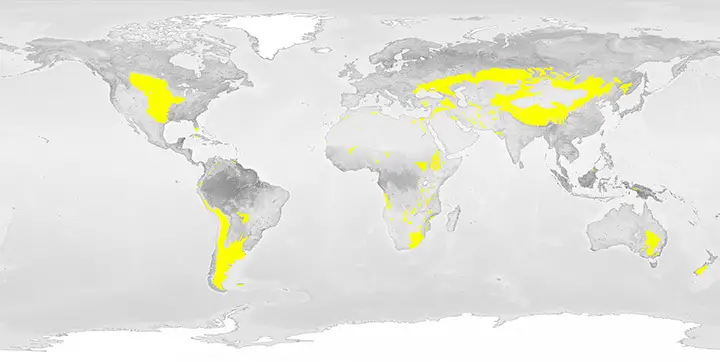
Temperate Grassland Facts
- Characteristics: Warm, low precipitation, foliage is mainly grass
- Temperature Range: -20°C / -4°F to 30°C / 86°F
- Precipitation: 500 to 900 millimeters / 20 to 35 inches of rain per year
- Vegetation: Various types of grass; wheat, barley, oats, prairie clover
Although there is some crossover of fauna from tropical grasslands in Africa, the largest predators that occupy the rest of the temperate grassland biome are coyotes, foxes and smaller felines such as the pampas cat. Coyotes are medium-sized canids that prey on smaller mammals such as deer, rabbits, hares and rodents as well as amphibians, fish and invertebrates. They are somewhat similar in appearance to a wolf but much smaller, with the average male weighing up to 20kg / 44lbs—grey wolves in Russia can weigh almost 80kg / 175lbs! The corsac fox is a majestic looking creature who inhabits the steppes of Central Asia. They occupy the middle of the food chain, being preyed upon by wolves, owls and eagles to name but a few.
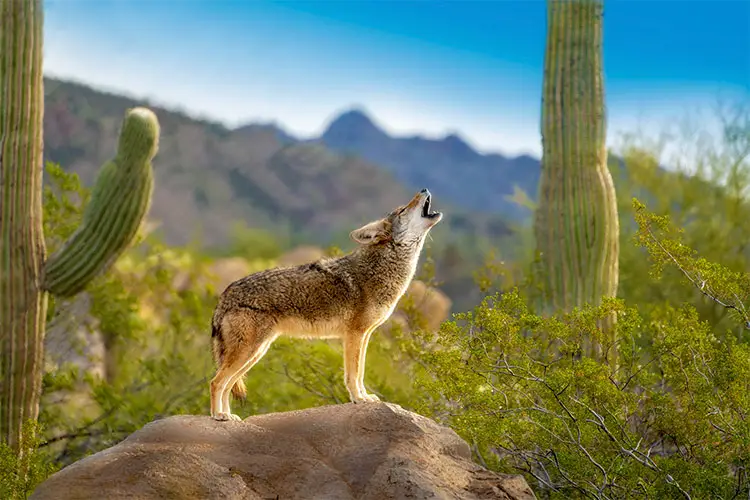
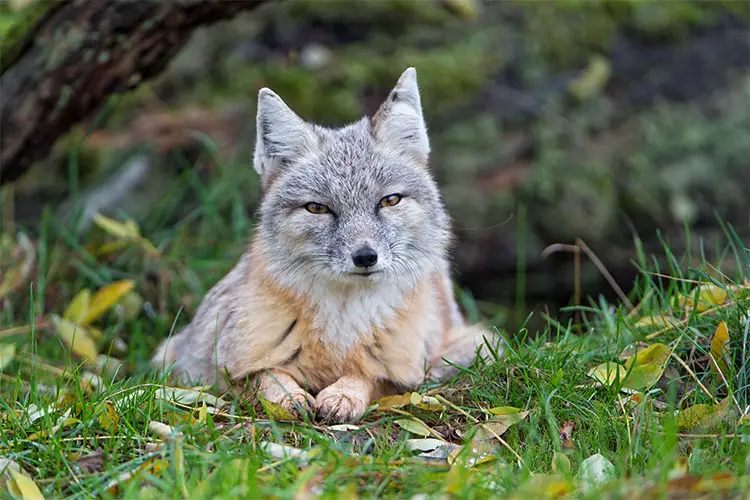
Left – Howling Coyote standing on Rock with Saguaro Cacti & Right – Corsac fox lying in the grass Flickr: Tambako The Jaguar
The largest of the grazing animals to occupy this biome is the bison; these gigantic bovines can weigh up to 1,000kg / 2,200lbs and spend most of the day munching on grass. There are only two extant species: the American bison occupies the plains of North America, while the European bison is found on the steppe in Eurasia. Smaller grazers include gazelles, wild horses and guanacos, which are found in South America. The Przewalski’s horse—also known as the Mongolian wild horse—is a hardy species of horse found in Mongolia. Taxonomically, they are considered to be the last “wild” horse, separated from all other breeds of domestic horse, which are a single species.
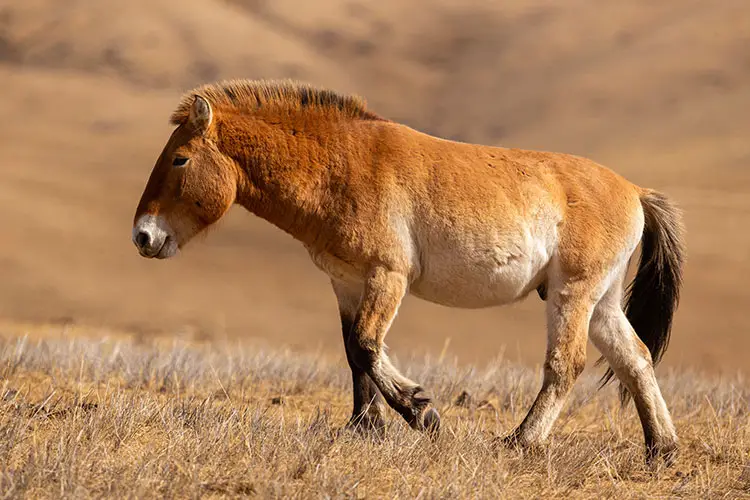
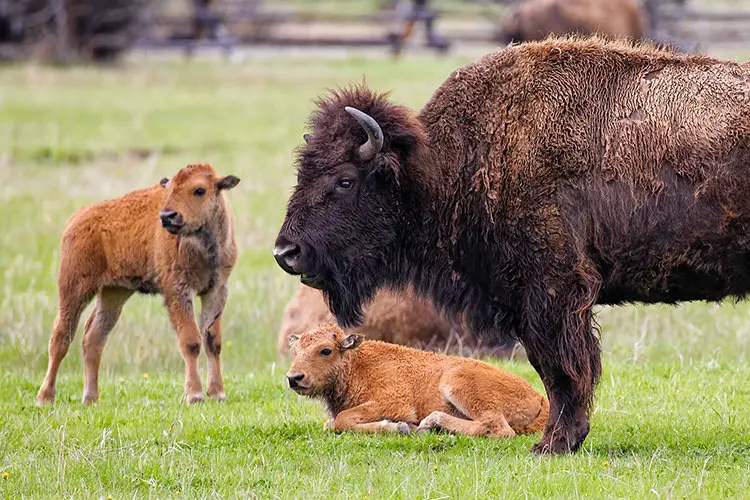
Left – Przewalski’s Horse, Hustai National Park, Mongolia & Right – Plains bison with calves in Utah | Unsplash: Philip Brown
There are many smaller mammals who call the temperate grassland biome their home including polecats, weasels, mice, rabbits, skunks, badgers & prairie dogs. The black-footed ferret—also known as the American polecat—lives in the prairies of North America and almost exclusively feeds on prairie dogs. They are part of a larger family of polecats, which also includes the marbled polecat, steppe polecat and European polecat. Prairie dogs are part of the squirrel family (they’re not actually dogs!) and are vital to the ecosystems in which they live; as well as being an important part of many predators’ diets, many other animals use the burrows created by prairie dogs for nesting.
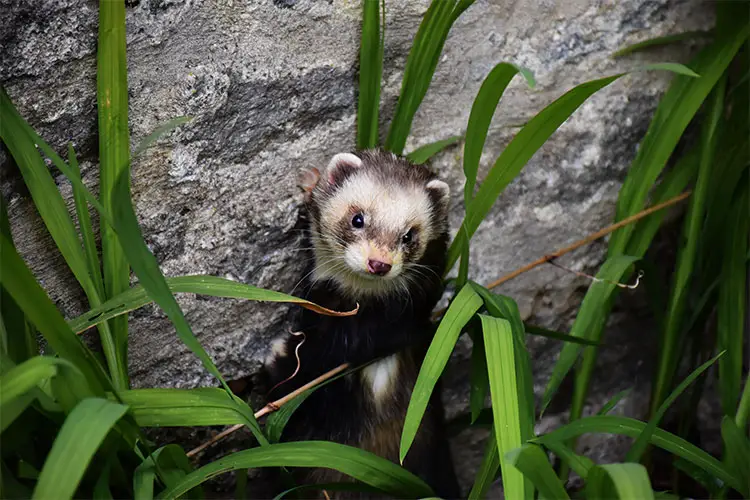
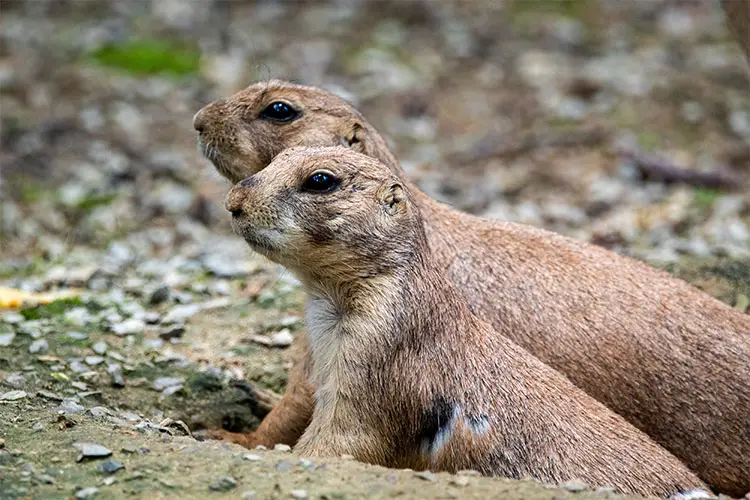
Left – The predator: the polecat Pixabay: u_3heuehh9 & Right – The prey: prairie dogs Unsplash: Joshua J Cotton
Blackbirds, sparrows and quails are some of the smaller birds that occupy this biome. The sparrow family is split into two main groups: old world sparrows and new world sparrows, which contain almost 200 species in total. The behaviour of sparrows differs from species to species; some are solitary creatures while others gather in flocks of up to 10,000 birds. Birds of prey including hawks, falcons, kestrels and eagles can also be found here, preying on small mammals, reptiles and other birds. The eastern imperial eagle can be found throughout much of Asia where it breeds in the grasslands of the north before migrating south for the winter.
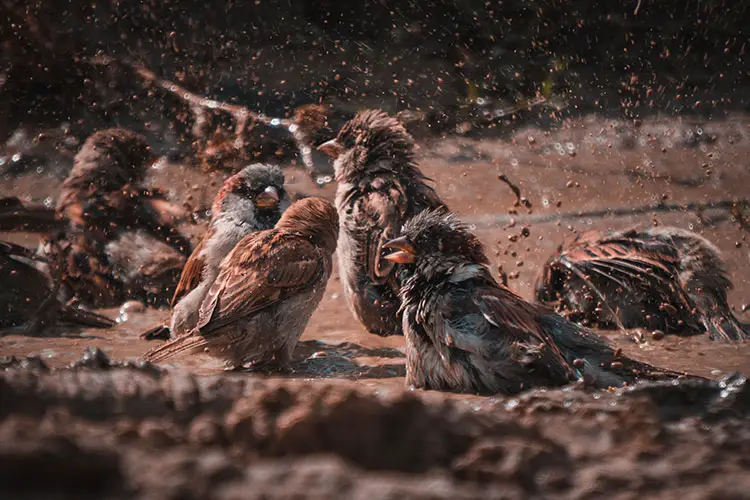
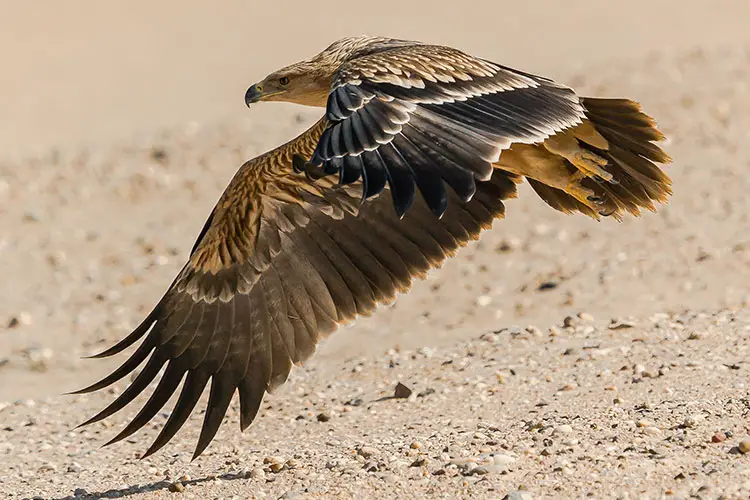
Left – Sparrows taking a dust bath | Pixabay: Paul Steuber & Right – Eastern Imperial Eagle | WikiCommons: Irvin Calicut
Desert
Desert accounts for around 25% of the world’s landmass and is characterized by extremely low precipitation and high temperatures. For the purpose of this article, we will talk about desert in general as one biome, however, it can be broken down further into four distinct types: hot and dry, semiarid, coastal and cold. Many plants in the desert—including cacti and various types of bush—exhibit spines or wool, which shade the surface of the plant, reducing the loss of water via transpiration. The animals of this biome have evolved to cope with the low levels of water and many animals here are nocturnal, only coming out at night when the temperature is lower.
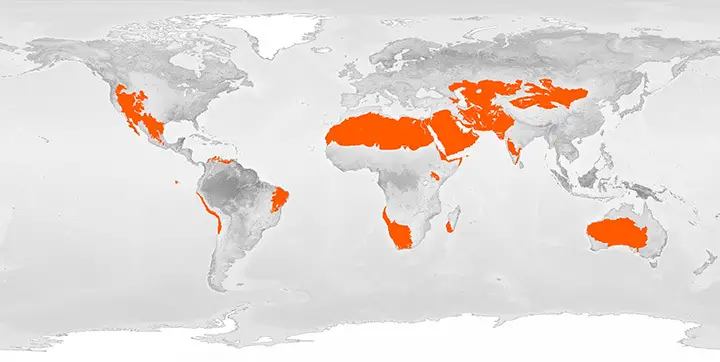
Desert Facts
- Characteristics: Hot, very low precipitation and sparse, hardy vegetation
- Temperature Range: -4°C / 25°F to 38°C / 100°F
- Precipitation: less than 300 millimeters / 10 inches
- Vegetation: Cacti & short bushes and grasses
Most of the mammals who reside in the desert are small, however, there are a few larger mammals who have adapted well to long periods without water. The camel is perhaps the most famous desert family and is split into 3 species: both the Bactrian camel and the wild Bactrian camel are found in Central Asia and have two humps, and the dromedary camel—also known as the Arabian camel— is found in the Middle East, the Sahara Desert and Australia. The Arabian camel is particularly adept at surviving in the desert environment, fluctuating its body temperature and reducing perspiration to last up to 10-15 days without water. Other larger mammals of the desert include the addax antelope and mule deer.
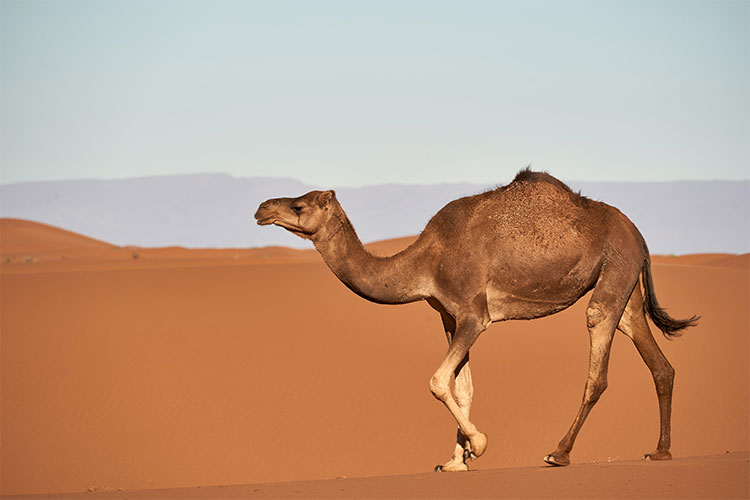
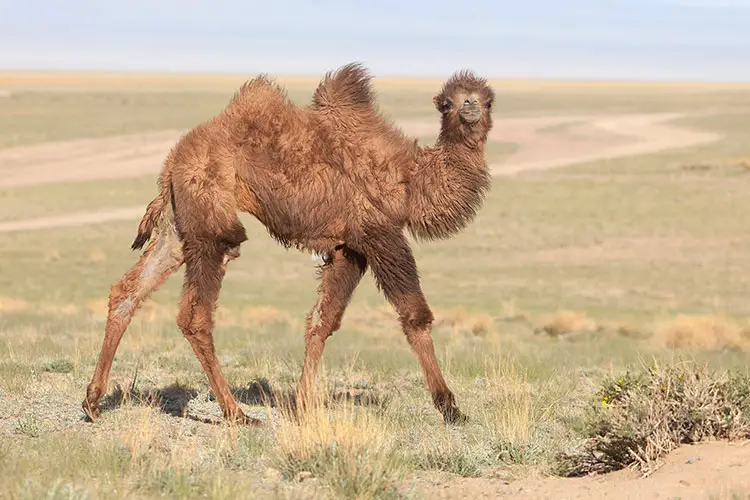
Left – Arabian Camel | Unsplash: Wolfgang Hasselmann & Right – Bactrian camel | WikiCommons: Alexandr frolov
The predators of the desert include various species of feline and canid. Both the cougar and the bobcat inhabit various biomes but are known to hunt for rabbits, hares and other small mammals in mountainous desert ecosystems. The bobcats of the desert exhibit a lighter coat than their forest-dwelling cousins, presumably to aid with camouflage. Canids include various species of fox and the coyote. The fennec fox lives exclusively in the Sahara Desert and is known for its large ears (relative to body size!), which can measure up to 10cm / 3.9in long and are used to dissipate heat.
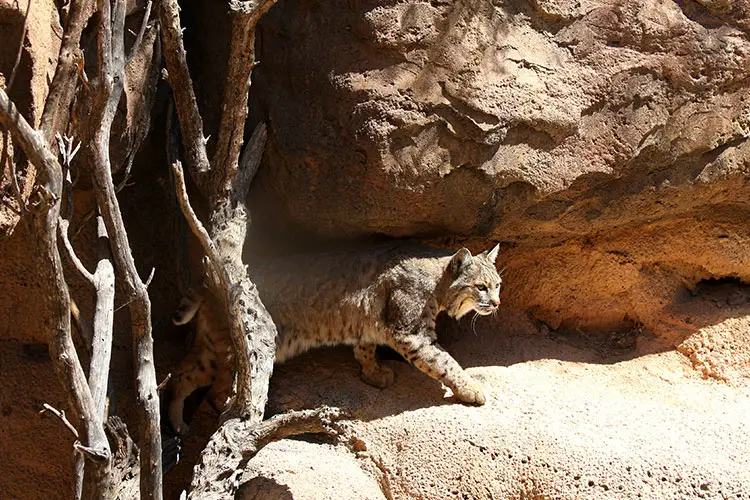
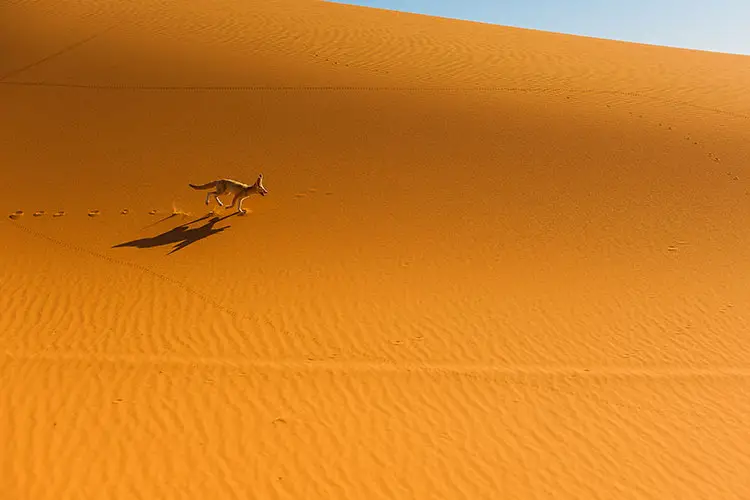
Left – Bobcat in Tucson, Arizona | Flickr: Bill Morrow & Right – Fennec fox in the Sahara Desert
Smaller mammals include hares, rabbits, the kangaroo rat, gerbils and meerkats. The kangaroo rat is so named due to its bipedal movement; it has large hind legs, which can be used to leap distances of up to 9ft / 2.75m. In order to survive the harsh desert climate, kangaroo rats live in complex burrow systems, the entrances of which they plug with soil during the day to regulate the temperature. Meerkats are found in the deserts of Southern Africa in complex social groups of up to 30 members. They feed mostly on butterflies, moths and beetles and also use burrow systems to escape the desert heat.
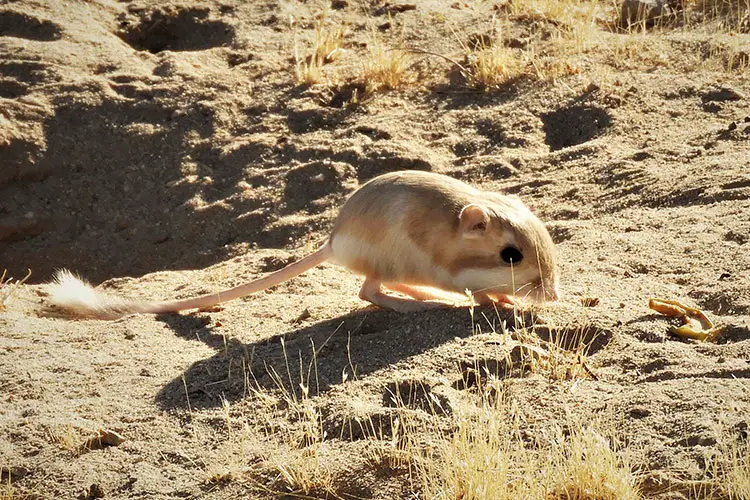
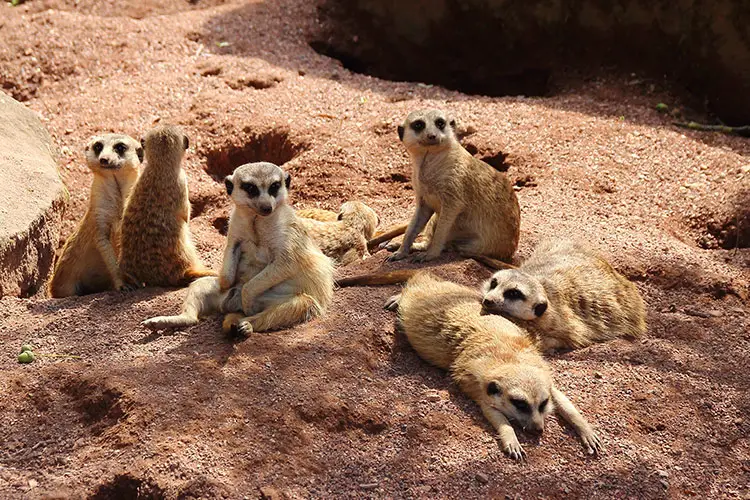
Left – Kangaroo Rat in the Mojave Desert, California | Flickr: gailhampshire & Right – A family of meerkats chillaxing | Pixabay: meineresterampe
Reptiles and invertebrates famously occupy the desert biome and range from scorpions and spiders to lizards and snakes. Rattlesnakes are a member of the pit viper family and are best-known for vibrating their tails, serving as a warning to the unwitting passerby or a predator. Rattlesnakes prey upon the small mammals of the desert including rats and rabbits and will also hunt birds. The scorpion family is a scary looking bunch; they have eight legs, two front pincers, and a large tail with a stinger at the end. They primarily live in desert ecosystems but also exist in many other biomes south of the taiga belt. They prey on small insects such as grasshoppers, beetles and bees. The spiders of this biome include tarantulas, the black widow and the wolf spider.
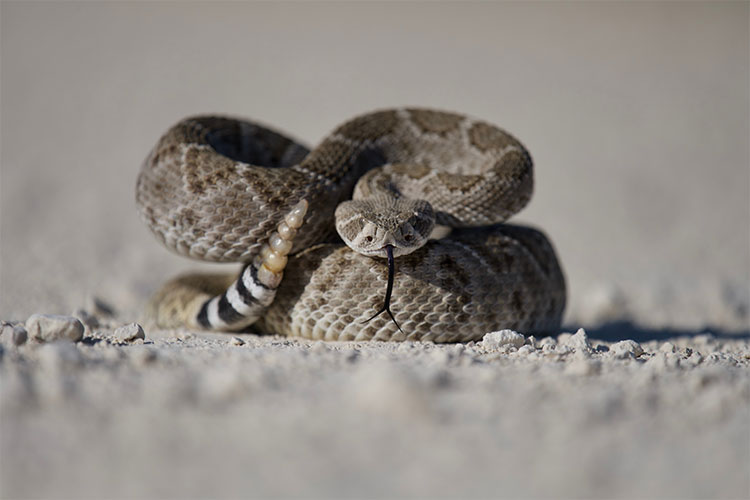
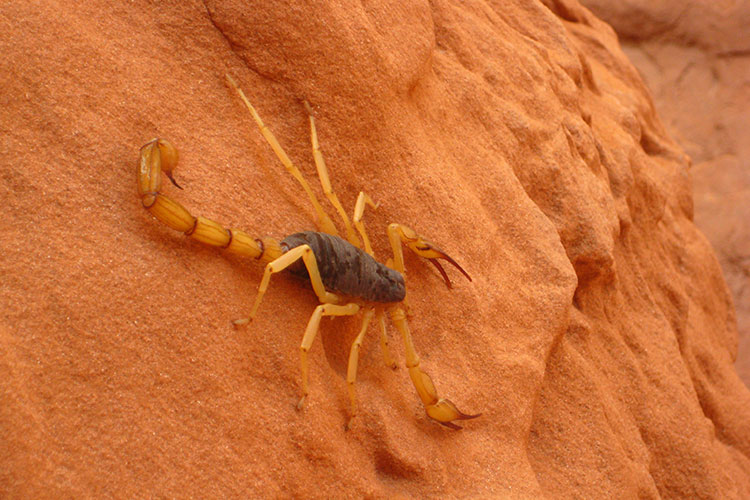
Left – Rattlesnake with visible rattle on the end of its tail | Unsplash: Duncan Sanchez & Right – Giant desert hairy scorpion in Arches National Park
The desert isn’t home to as many birds as biomes such as tropical rainforest but those who do abide are hardy and distinct. Made famous in the desert landscape of the Wile E. Coyote and the Road Runner cartoons, roadrunners are a member of the cuckoo family endemic to North America; they are omnivorous, eating both plant matter and a variety of insects, reptiles and small mammals and can run at speeds of up to 27mph / 43kph. Another interesting desert bird is the burrowing owl who are present throughout much of the Americas. They steal the burrows of animals such as prairie dogs and use them for nesting and protection from predators. As rattlesnakes also occupy the burrows of ground squirrels, burrowing owls have developed the ability to mimic their rattle—this is known as Batesian mimicry, a type of mimicry used by harmless animals to mimic the warning signals of harmful species.
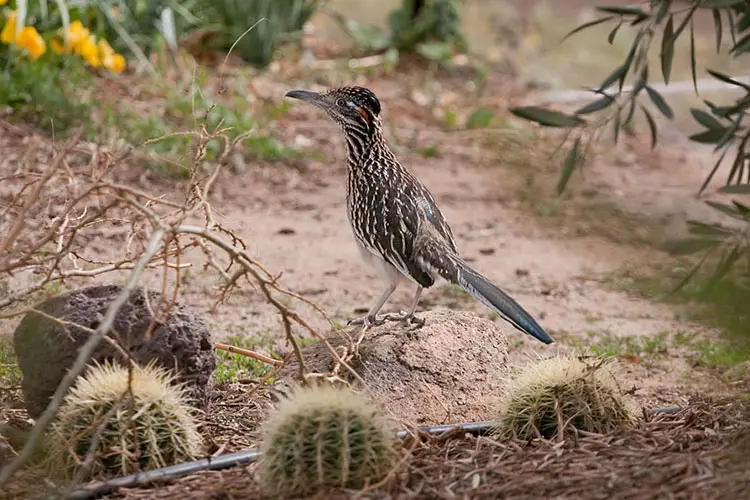
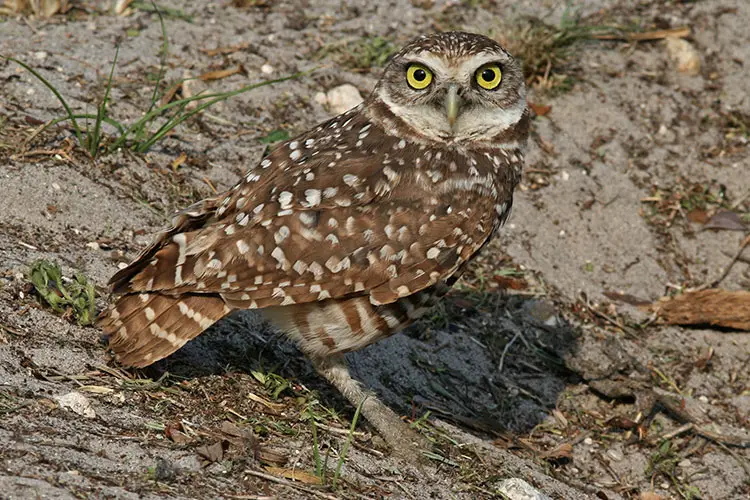
Left – Roadrunner | Flickr: David O & Right – Florida burrowing owl | WikiCommons: birdphotos.com
There are many species of insect that exist in the desert from ants, bees and beetles to grasshoppers, butterflies and moths. Viceroy butterflies are known to exist in the desert biome and, like burrowing owls, mimic another species—the monarch butterfly—as a defence against predators. This type of mimicry is known as Müllerian mimicry, where two equally well-defended species mimic each other’s appearance to their mutual benefit—in the case of butterflies, this defence is a foul taste.
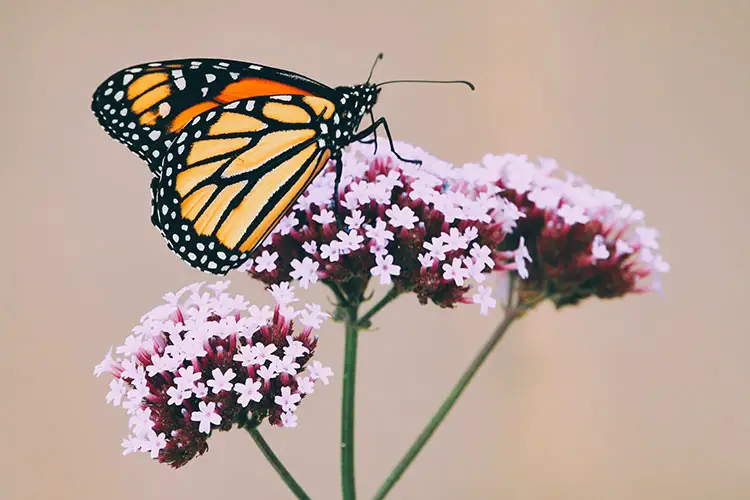
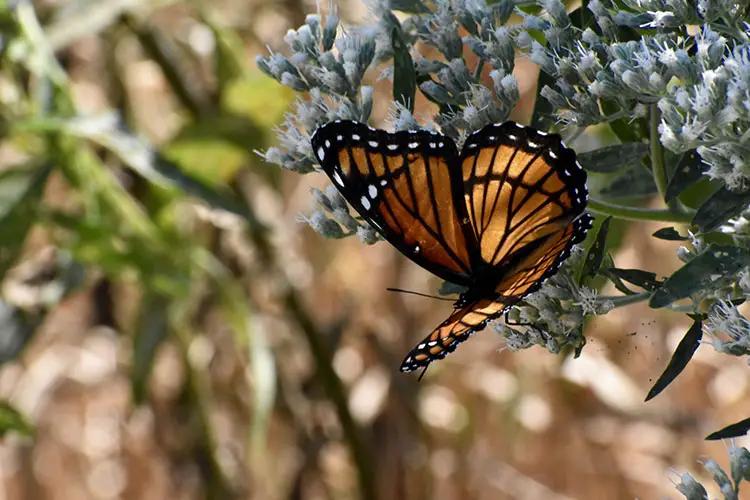
Left – Monarch butterfly Unsplash: Sam Mgrdichian & Right – Viceroy butterfly Pixabay: Terry Murphy
Aquatic
71% of the earth’s surface is made up of water. So, although we have already discussed a tremendous amount of biodiversity, in reality, we have barely touched the surface (get it?!). The aquatic biome consists of two main types, marine and freshwater, distinguished by their concentrations of salt. Although there are some fairly large animals in the lakes and rivers of the freshwater biome, the world’s largest creatures abide in the open ocean. Those who live under the surface such as fish, whales and squid are not the only types of animals to be classified as existing in the aquatic biome; both marine and freshwater biomes are home to a tremendous amount of birds and many other types of animal whose aquatically inclined evolutionary path make them just as much a part of the aquatic biome as their distant water-dwelling relatives.
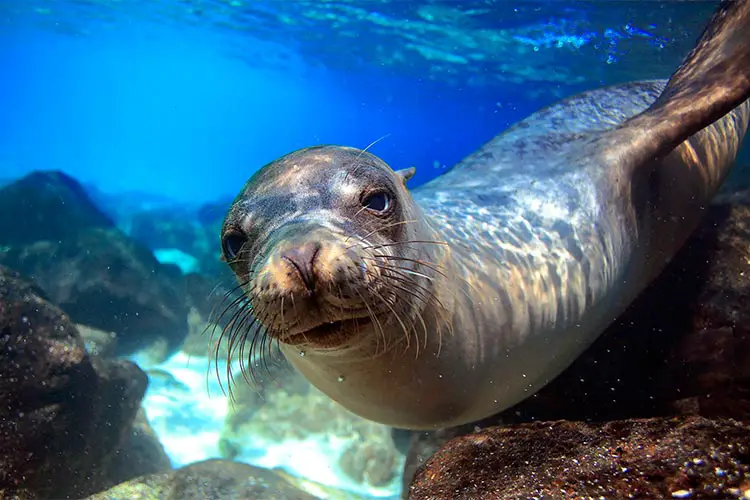
Marine
By far the largest biome of any on the list, the marine biome is classified as any body of water with a salinity of 0.5ppt or more—the concentration of salt measured in parts per thousand. There are three main types of ecosystem within the marine biome: ocean, coral reef and estuary. Estuaries are bodies of water that form transitional zones between freshwater and saltwater ecosystems; the brackish water found therein has more salt than freshwater but less than seawater. Coral reef ecosystems—also known as the rainforests of the sea—are created by colonies of coral that usually grow in warm, shallow water and play host to an incredible amount of biodiversity. Finally, the open ocean is home to the largest animals on the planet including 200-tonne whales, 2,250kg / 5000lb great white sharks and 500kg / 1000+lb squid.
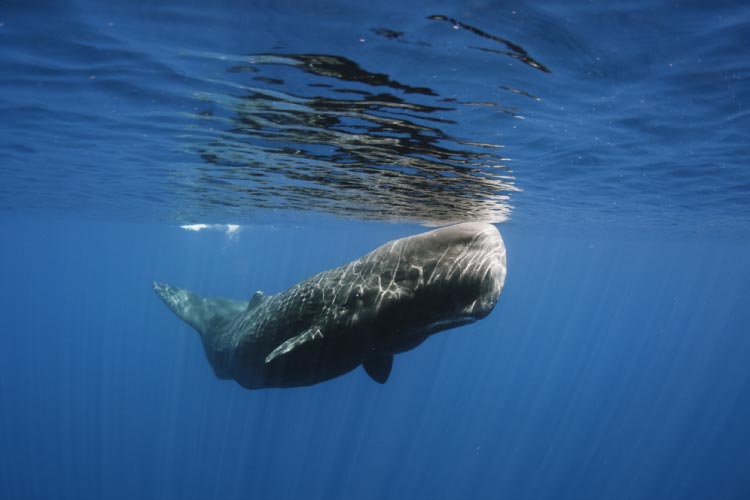
The infraorder cetacea contains most of the well-known aquatic mammals including whales, dolphins and porpoises. Blue whales are the largest animals on the planet and can reach lengths of almost 30m / 100ft. Unlike most whales, who eat fish, plankton and algae, killer whales—also known as orcas—are apex predators who hunt in groups and will prey upon other species of whale, seals and many species of fish. If orcas were the bears of the sea, manatees would be the cows (hence why they’re also known as sea cows!); manatees are herbivorous mammals that eat around 50kg of grasses, algae and weeds each day—around 10-15% of their body-weight.
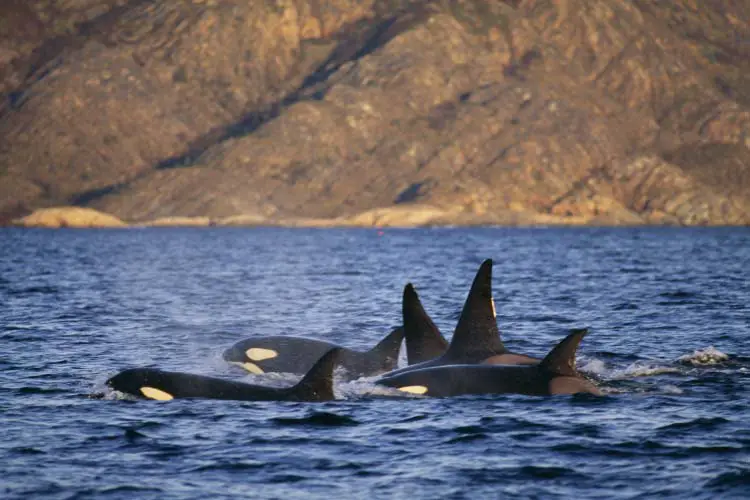
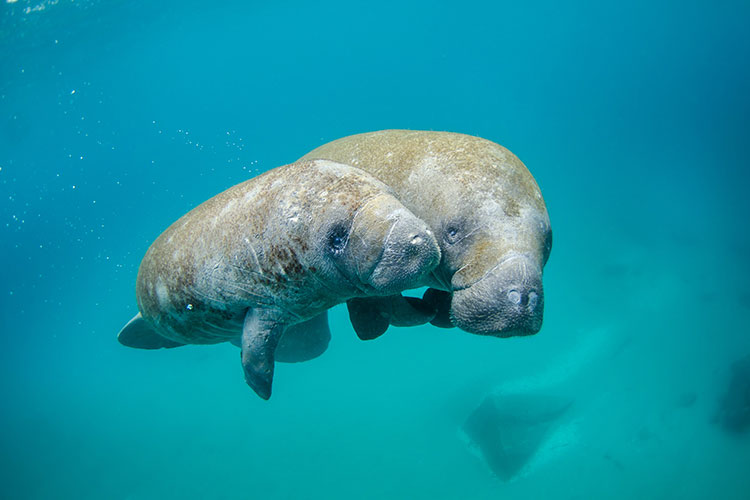
Left – Group of killer whales in Norway & Right – Mother manatee and calf swimming out of an inlet Unsplash: NOAA
Pinnipedia is another group of marine mammals that contains seals, sea lions & walruses, mostly found in frigid waters outside of the tropics. The southern elephant seal is the largest of this clade—and the largest marine mammal outside of cetacea—weighing in at a hefty 3,200kg / 7,100lbs! These gigantic seals are found only in the water surrounding the Antarctic where they prey on fish and squid at depths of up to 1km / 3,300ft. The walrus is another iconic pinniped species and the second largest overall. They are found on the opposite side of the planet to the elephant seal, in the waters of the Arctic circle where they spend a great deal of their time on land searching for molluscs to eat.
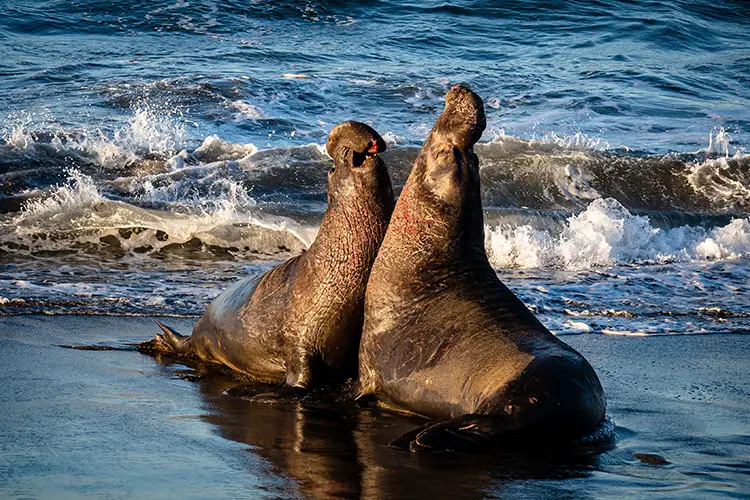
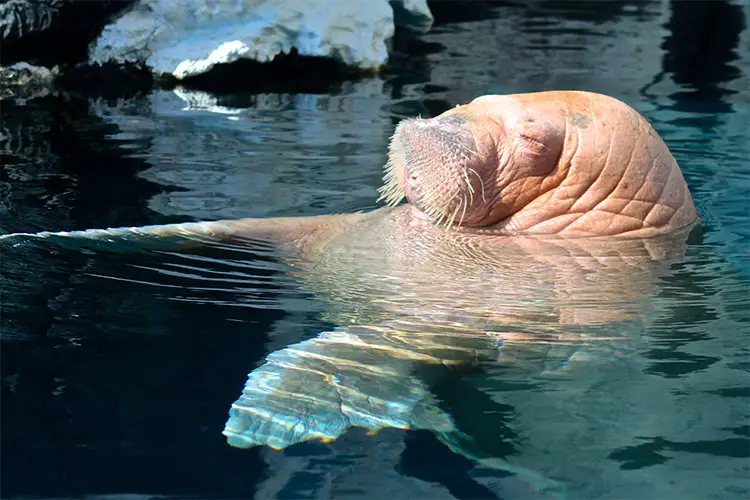
Left – Elephant Seals fighting in the breeding season Unsplash: Anchor Lee & Right – A relaxed walrus! Pixabay: nightowl
Many of the reptiles you’ll find in the freshwater biome can also be found in the marine biome too but much larger. Sea turtles are a superfamily of Cryptodira—a suborder containing most of the world’s tortoises and turtles—and contains species such as the hawksbill, leatherback and green sea turtle. Hawksbills are found in the shallow coral reefs of the tropics where they feed mostly on sea sponges—making up around 70-95% of their diet. Saltwater crocodiles are the largest of the crocodilian order measuring up 6m / 20ft in total length and weighing up to 1,300kg / 2,900lbs. The largest saltwater crocodile ever recorded was found in the Bay of Bengal in 1840, it measured over 10m / 33ft and weighed 2,721.5kg / 5,990lbs, yikes! They are found in the brackish mangrove swamps of southeast Asia and northern Australasia.
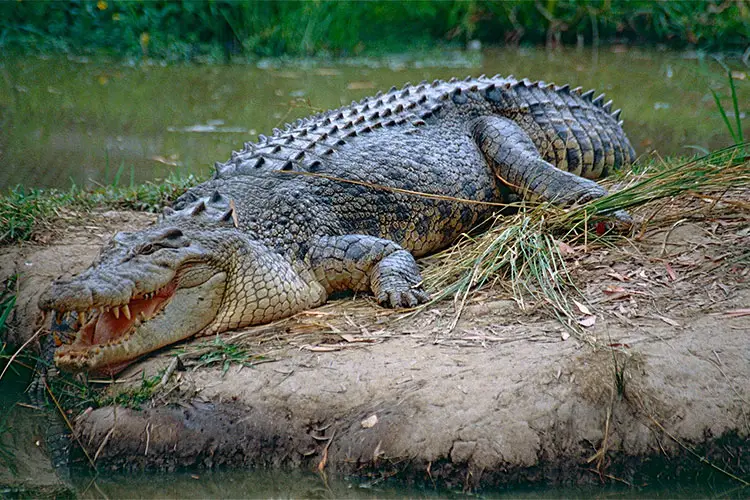
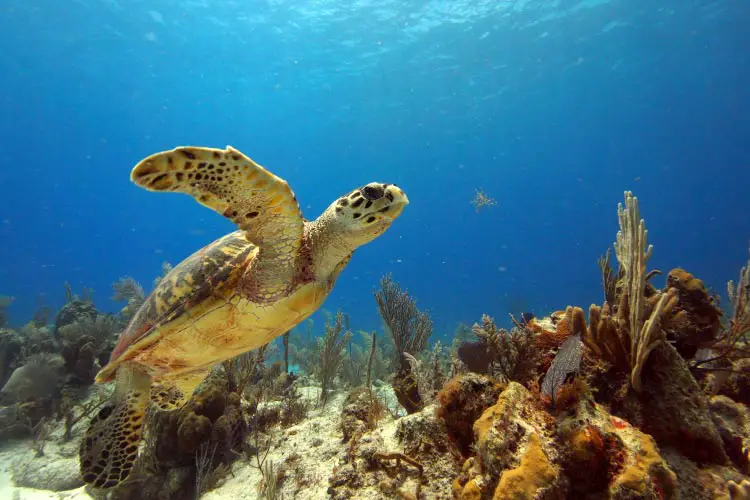
Left – Saltwater crocodile | WikiCommons: Bernard Dupont & Right – Hawksbill sea turtle
Fish are divided into three groups: Chondrichthyes, Osteichthyes and the smallest of the three, Agnatha—jawless fish. Chondrichthyes are cartilaginous fishes that have skeletons composed primarily of cartilage, they are mostly marine species and include sharks, rays and skates. The most feared of all Chondrichthyes, the great white shark preys mostly on marine mammals and has no known predators other than the orca. Growing up to 9m / 30ft, the largest of all sharks, the whale shark is much more placid and can be found in the topics feasting on plankton, fish eggs and krill. Batoidea is a superorder of Chondrichthyes more commonly known as the ray family. The manta ray is the largest of this family and, like the whale shark, is also a filter feeder; they are found in tropical waters where they feast on zooplankton.

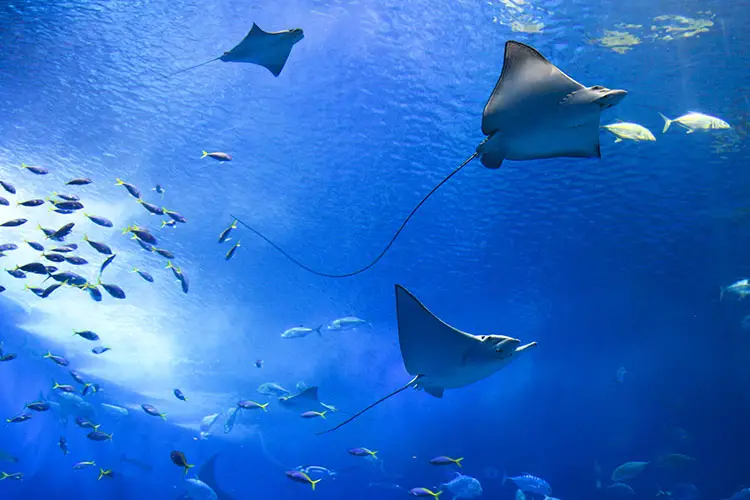
Left – Great white shark & Right – Group of Manta Rays | Unsplash: Sense Atelier
Osteichthyes are bony fish that have skeletons composed primarily of bone, this group is the most diverse containing over 28,000 species. Many of the fish you’ll see in coral reef ecosystems are bony fish such as parrotfish, the moray eel and clownfish. The moray eel is a carnivorous predator that preys on small fish, octopuses and crustaceans. Made famous in the 2003 film, Finding Nemo, clownfish are a particularly beautiful species of reef fish. They can be found swimming in between the tentacles of sea anemone with whom they have a symbiotic relationship—providing each other with many benefits including protection from predators or parasites. Other examples of bony fish include tuna, swordfish and the gigantic ocean sunfish—the largest of all bony fish, weighing up to 1,000kg / 2,200lbs.

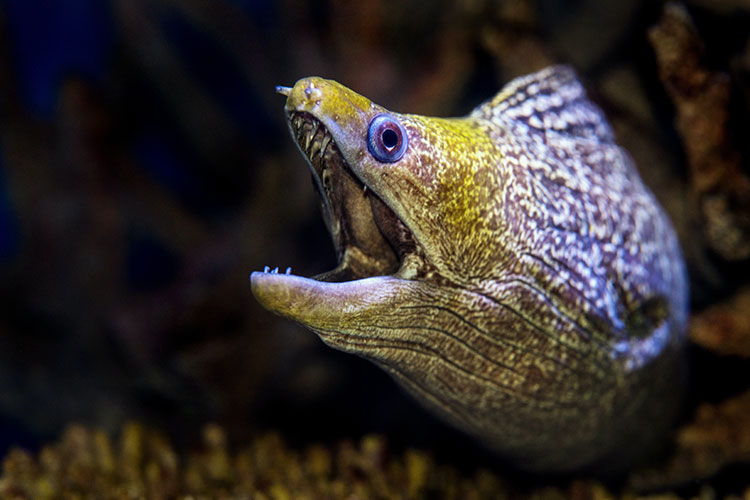
Left – Clownfish swimming in between sea anemone & Right – Moray Eel with powerful jaws | Unsplash: David Clode
The invertebrates of the marine biome range from crustaceans such as lobsters and crabs to jellyfish, cephalopods such as octopus and jellyfish, bivalves such as mussels and oysters, and coral. Octopus have eight limbs—called arms—which they use to walk on the seafloor and forage for food. Each arm is covered in suckers, which they use as grip to either secure their position or to move other objects. Coral is perhaps the most inconspicuous animal in this entire article! Often confused for a plant, coral are marine invertebrates with tentacles, mouths and a digestive system. The Great Barrier Reef is the largest coral reef system in the world, stretching 1,400mi / 2,300km off the northeast coast of Australia.
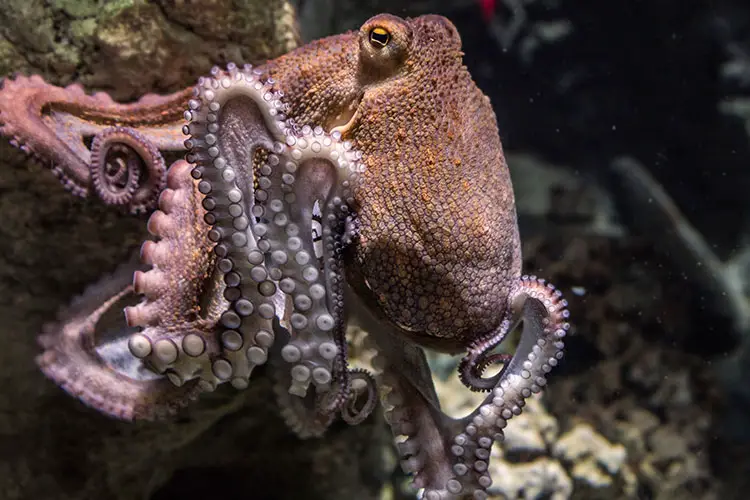
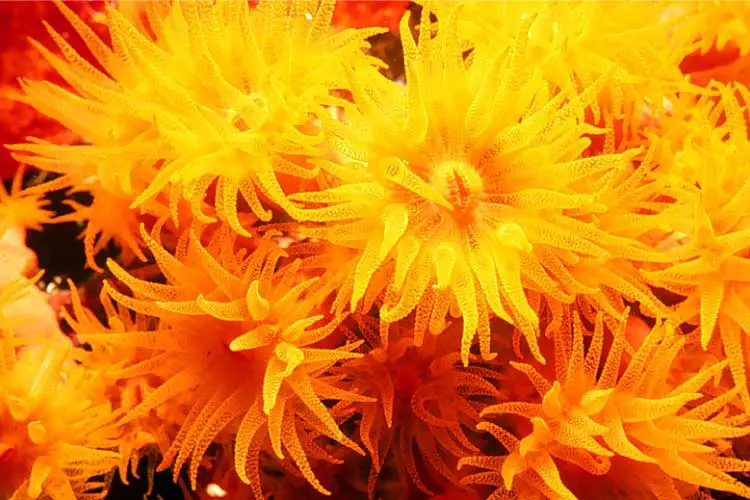
Left – Octopus with tentacles and suckers | Pixabay: Edmondlafoto & Right – Daisy coral feeding on the Great Barrier Reef, Australia | Flickr: Wibble Roisin
There are many birds that have evolved to thrive in the marine biome, sporting thick feathers and boasting a variety of fishing techniques. Puffins are split into three species, all of which reside in the northern hemisphere; they live in rabbit burrows on the edges of cliffs where they breed and fish for herring, sand eel and capelin. Whereas puffins live in the frigid waters of the north, boobies are found mostly in the tropics. Blue-footed boobies are found on the west coast of Central and South America and sport colourful blue feet which develop thanks to the pigments found in the fish it eats. Other examples of marine birds include albatross, gannets and penguins.
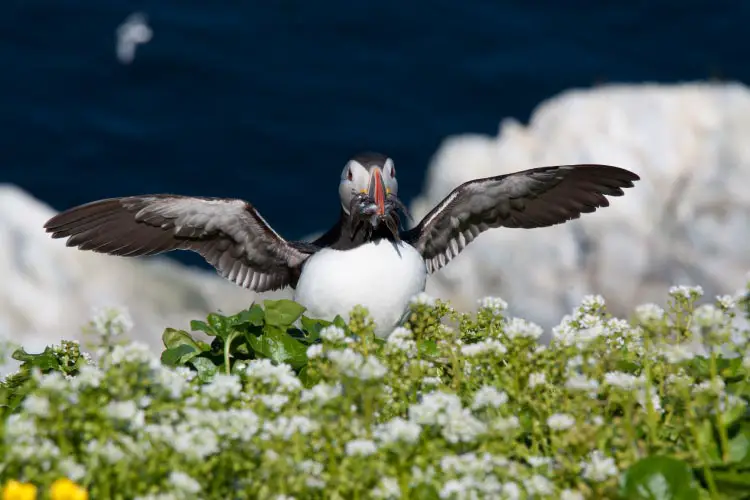
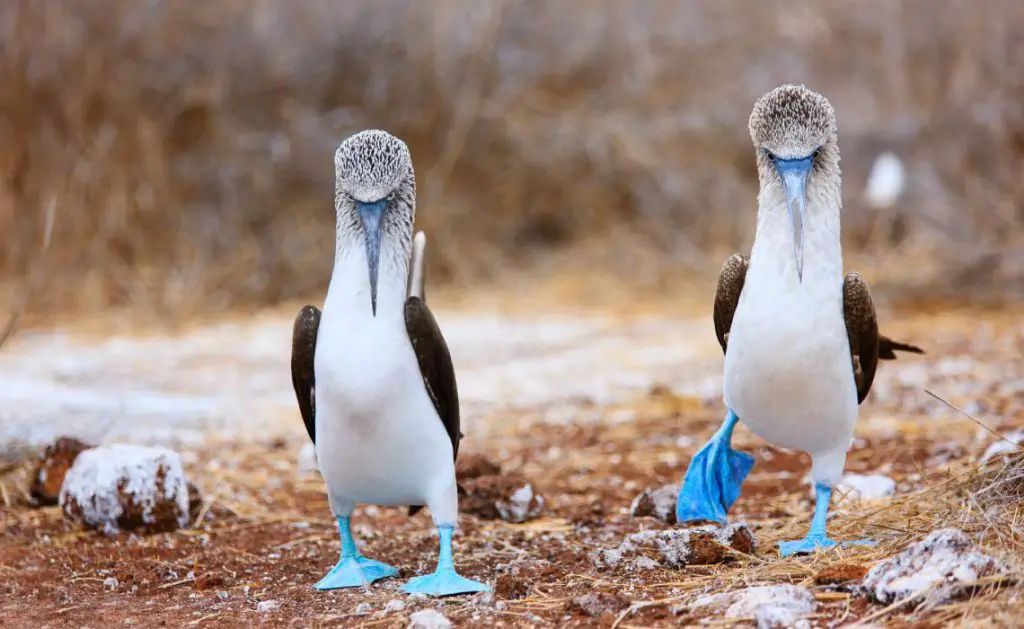
Left – Atlantic Puffin post-fishing in Norway | Flickr: talaakso & Right – Blue-footed booby on the Galapagos Islands
Freshwater
The freshwater biome is characterized by a low level of salt and can be broken down into three main categories: ponds and lakes, streams and rivers, and wetlands. Ponds and lakes are commonly isolated from other aquatic ecosystems and therefore often lack a large amount of diversity. Streams and rivers transport rainwater from regions of higher altitude to the ocean; they contain their own unique fauna and also act as migratory paths for animals such as salmon. Wetlands are shallower bodies of water that support the growth of plants such as lilies; there are many wetlands that are not considered true freshwater ecosystems due to their high concentration of salt. Whereas the marine biome is held almost exclusively for water-dwelling animals, the freshwater biome boasts a large crossover, with many animals using both the surrounding land and water to live.
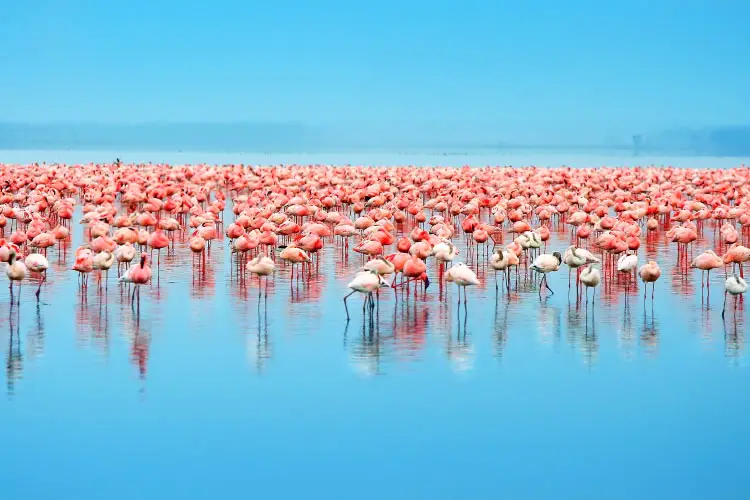
The fish of the freshwater biome are significantly smaller than that of their open ocean cousins, however, thanks to the isolation of many ecosystems, they share around 40% of the total number of species. Examples of freshwater fish include trout, pike, bass and catfish. Piranha are omnivorous fish that live in the Amazon basin in South America. Although they are touted in Hollywood films as extremely dangerous to humans, they mostly feed on other fish, insects, worms and crustaceans. There are also many species of fish that live in the sea but migrate through freshwater rivers and streams to breed such as salmon and trout. Bears take advantage of the salmon run each year and will wait at waterfalls to catch the salmon making a dash for their breeding grounds further upstream.
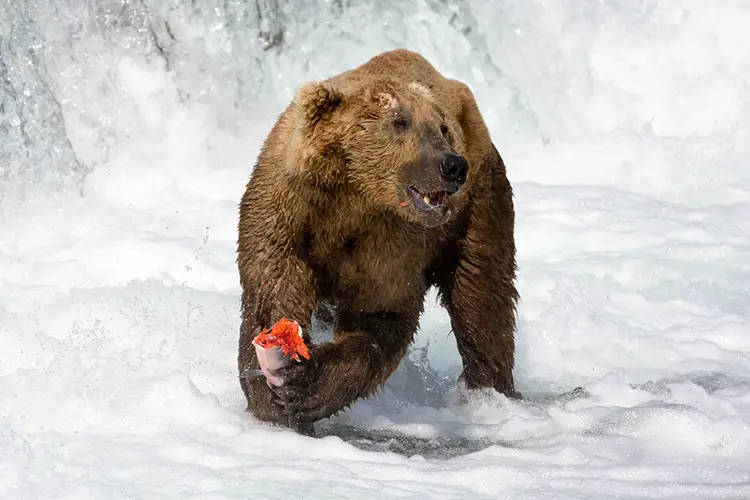
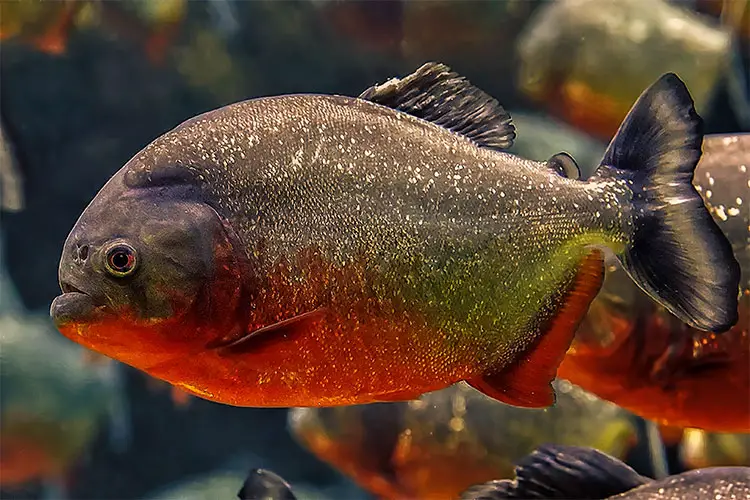
Left – Grizzly bear enjoying the salmon run in Alaska & Right – Red-Bellied Piranha | Pixabay: Rethinktwice
Ducks, swans and geese are members of Anatidae, a family of waterbirds containing 174 species found on every continent with the exception of Antarctica. Like ducks and geese, swans are mainly herbivorous, feasting on the roots, stems and leaves of aquatic plants. They form strong monogamous bonds with their mating partners and can often be seen floating gracefully together in rivers and lakes. Other birds of the freshwater biome include kingfishers, herons, osprey and pelicans. Kingfishers are also found on every continent and sport colourful plumage, often found in vibrant blues, oranges, reds and yellows. As their name would suggest, many species of kingfisher are adept at fishing but their diet also includes amphibians, worms, insects and spiders.
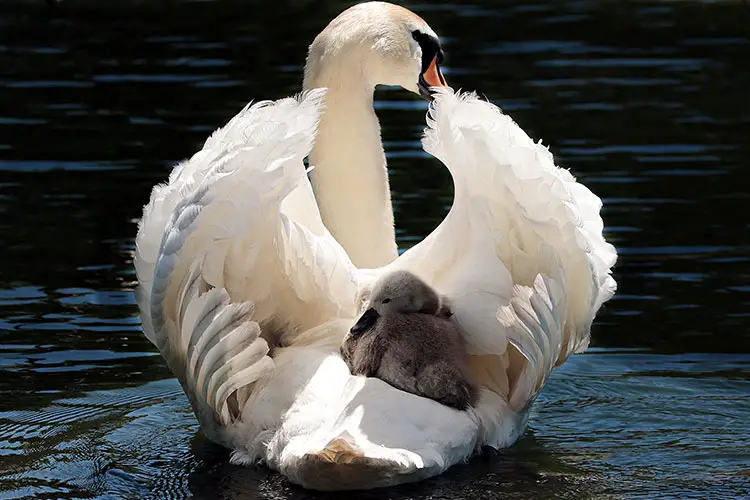
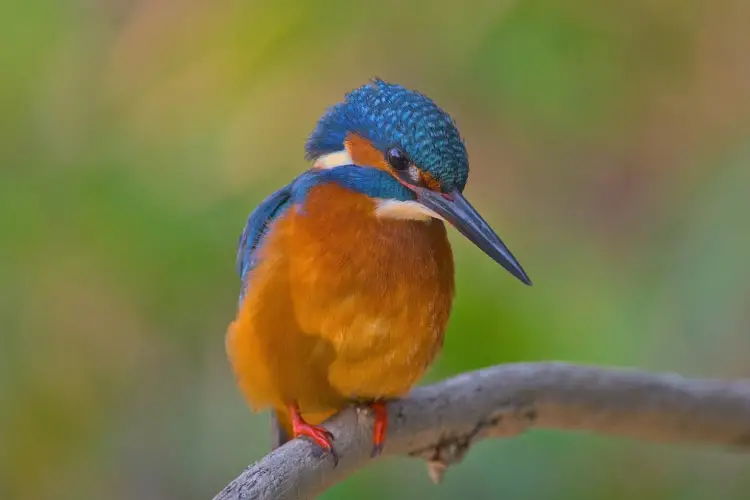
Left – Pen giving her cygnet a piggyback ride! | Pixabay: Hermann & Richter & Right – Kingfisher in Andalusia, Spain | Flickr: elitro
Many mammals have also evolved to thrive in freshwater; otters, beavers, river rats and capybara are just a few of the species that abide in freshwater ecosystems. The giant river otter is the largest member of the weasel family and can measure up to 1.7m / 5.6ft. A social animal, they live in dens on the banks of rivers and lakes where they mostly prey upon fish such as piranha and catfish—although they have also been known to take down caiman and anacondas! The platypus—also known as the duck-billed platypus—is an aquatic mammal endemic to the east coast of Australia. The males of the species have a spur on their ankle that secretes venom if attacked; this is not lethal to humans but would be enough to kill a small mammal such as a dog.
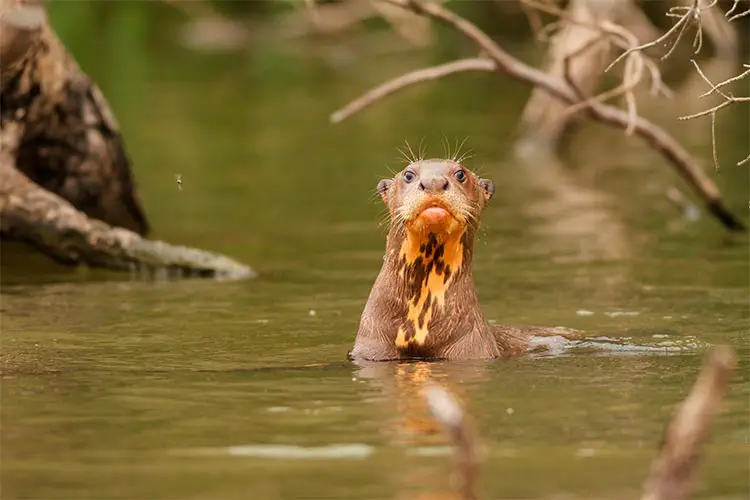
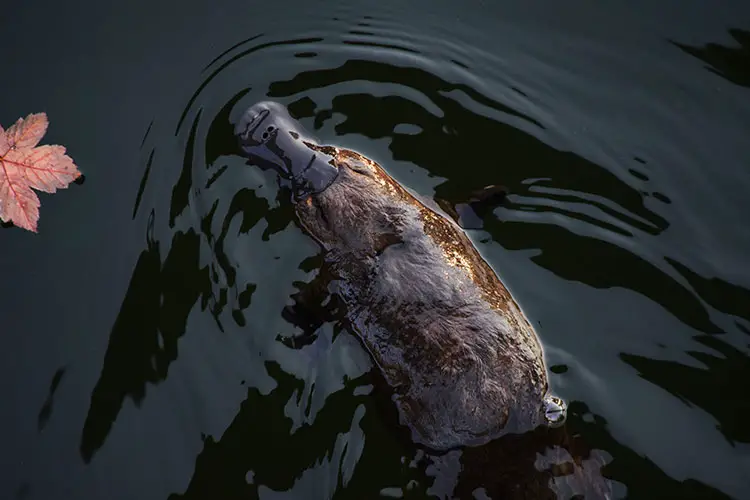
Left – Giant Otter swimming in the Amazon & Right – Platypus in Tasmania Unsplash: Meg Jerrard
Although some species of frog have adapted to reproduce without a body of water, most amphibians start their life as larvae laid in freshwater—also known as tadpoles. Animals in this classification of vertebrates include frogs, toads, salamanders, newts and caecilians. The axolotl is a species of salamander native to only two freshwater lakes in Mexico and, unfortunately, is on the brink of extinction. Also known as the Mexican walking fish, the axolotl is carnivorous, feeding on insects, molluscs, worms and other invertebrates. Bullfrogs are large frogs known to be particularly aggressive, often preying on small rodents, other frogs, spiders, lizards and much more. They are ambush predators who strike prey with their long tongues before reeling them into their powerful jaws (thank god they’re only 20cm long!).
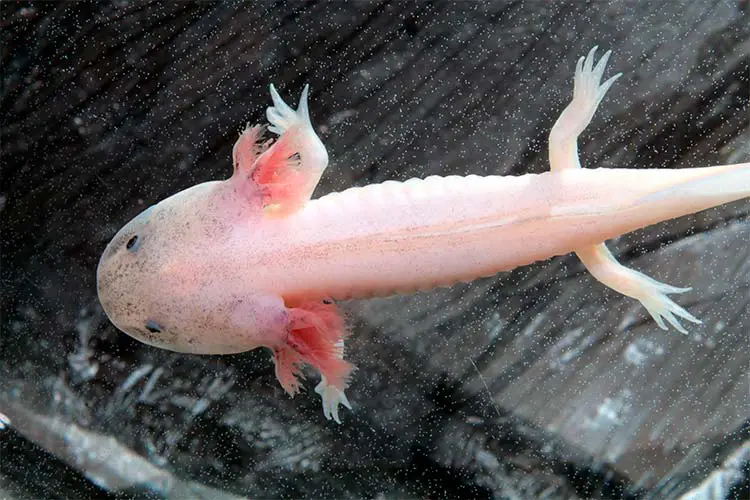
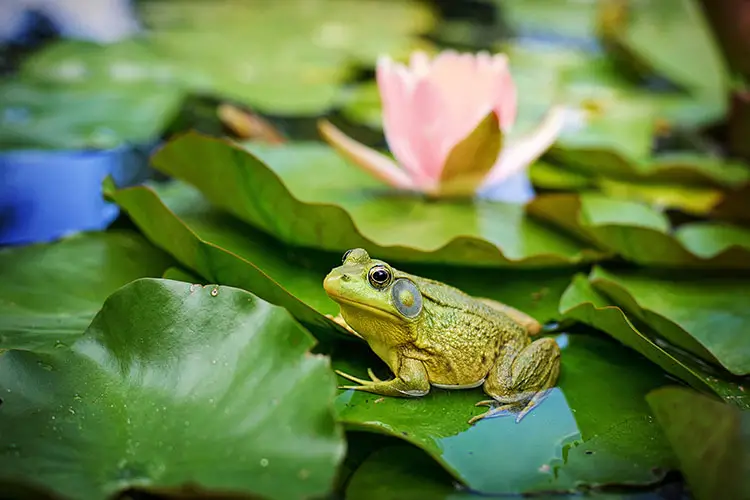
Left – Axolotl aka the Mexican walking fish & Right – Bullfrog resting on lily pads | Pixabay: Jill Wellington
The reptiles of the freshwater biome range from members of Crocodilia such as crocodiles, alligators, and caiman to turtles and snakes. Caiman are found in swamps, mangroves, and other freshwater ecosystems in central and South America. Preying mostly on fish, they are the smallest of the crocodilians weighing up to 40kg / 88lbs and measuring no more than 4m / 13ft. Emydidae is a family of turtles found in the freshwater biome more commonly known as terrapins. The pond slider is a species of terrapin endemic to the south-eastern United States; it has three subspecies, the most recognizable being the red-eared slider, which has a small red stripe around its ears.
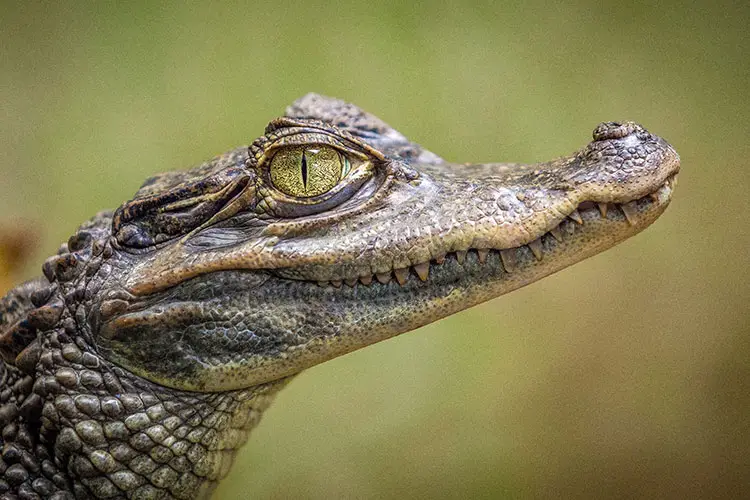
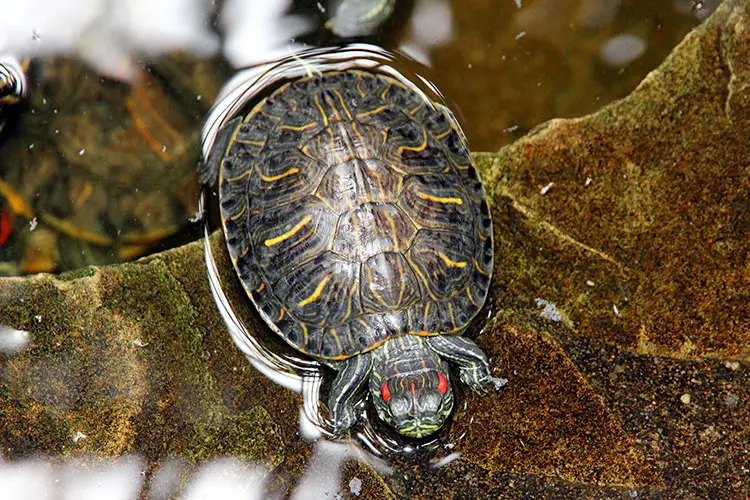
Left – Young caiman | Unsplash: Gaetano Cessati & Right – Red-eared slider turtle | Pixabay: zoosnow
Many insects use bodies of freshwater to lay their eggs including dragonflies, mayflies and mosquitoes. Dragonflies are a family of territorial flying insects, containing over 3,000 species. They perch on plants overlooking sunlit shallow waters where they prey on other smaller insects. They are well-known for having metallic coloured bodies/eyes and large transparent wings. Water striders (aka Jesus bugs!) are another family of insects—containing 1,700 species—who use their hydrophobic legs to help them traverse across bodies of water without breaking the surface. Interestingly, although they are found mainly in the freshwater biome, around 10% of their species are marine. Other freshwater invertebrates include leeches, crayfish & freshwater crabs.
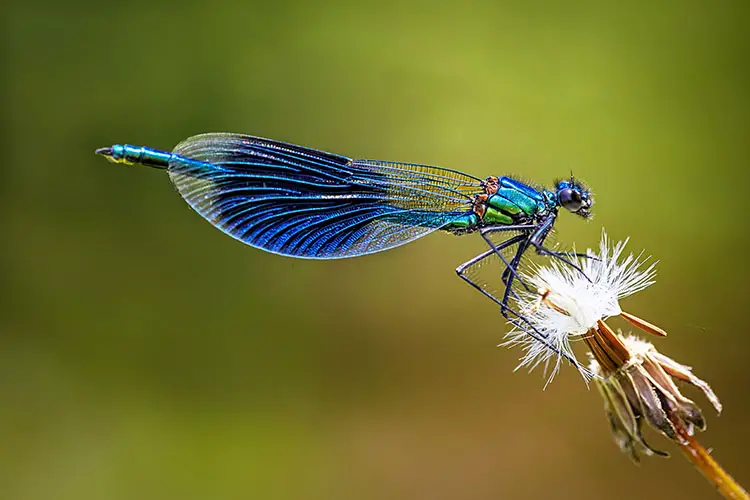
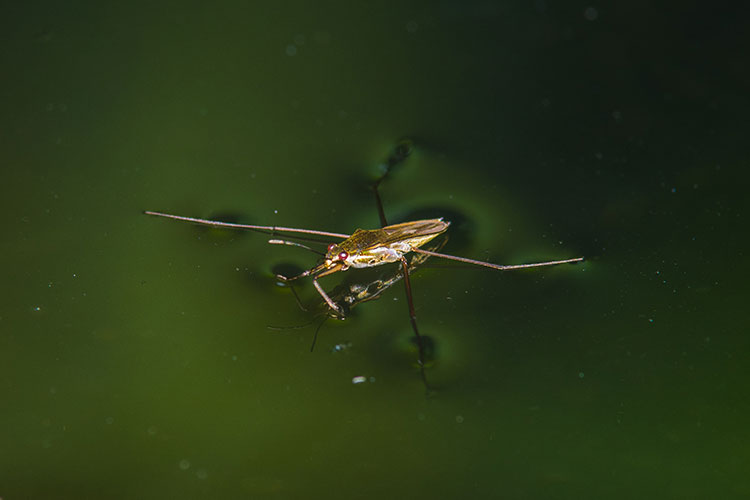
Left – Dragonfly perched on a flower | Unsplash: Dorothea Oldani & Right – Water strider | Pixabay: Julia Schwab
Sources
NASA Biomes, University of Berkeley Biomes, Encyclopedia Britannica, Wikipedia, Grida Biome Maps, Byju’s Types of Ecosystem, Biome vs Ecosystem, Tundra Flora and Fauna, Tundra Predators, Animals of the Taiga, Taiga Animals, Animals of Deciduous Forests, Rainforest Layers, Anaconda Facts, Insects of the Rainforest, Types of Grassland, Biomes: Savannah, Animals of the Savanna, Savannah Animals, Desert Habitats, Desert Ecosystems, Desert Birds, Desert Insects, Types of Aquatic Biome, Animals of the Marine Biome, Most Biodiverse Countries
